


















































































COME EXPERIENCE FALL AT FRIENDS HOMES
and see why joining the waiting list now gives you so much more to look forward to for your future.
Our fall tours, lunches and events are in full swing, creating delightful opportunities to see what life on campus is all about. Tour the updated amenities, state-of-the-art wellness center, fabulous dining choices, thriving campus trails and gardens. But most importantly, experience the welcoming, friendly residents and staff that make our community unique.
You’ll also see how to get priority access to available apartments, townhomes and cottages that are right-sized to fit your active lifestyle. So when you’re ready to make your move, your Friends Homes residence can be ready for you.
Scan the code, call or
learn more.
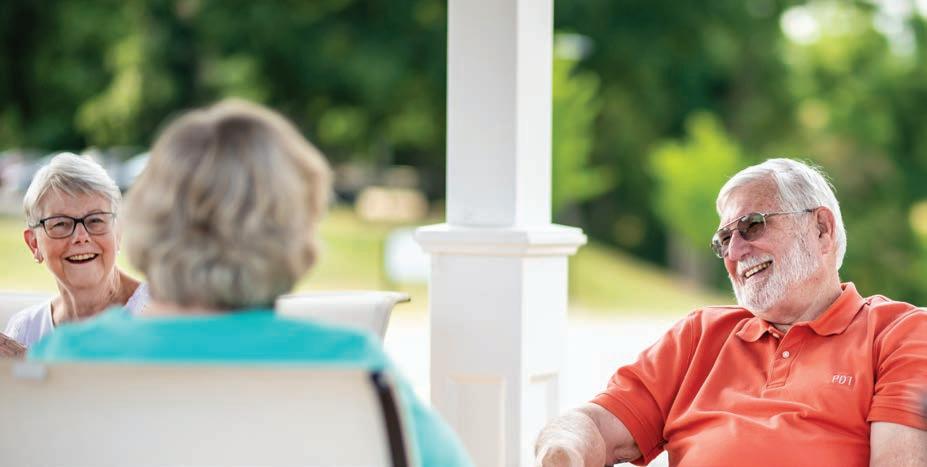



Tune in to learn about a number of City services, that can improve your quality of life, such as:
• Affordable Housing Resources
• Emergency Preparedness
• Emergency Response
• Housing Rights


• Language Access Services
• Library Services
• Minority-Owned Business Resources
• Parks and Recreation
• Police and Community Relations
• Safety & Security
• and More

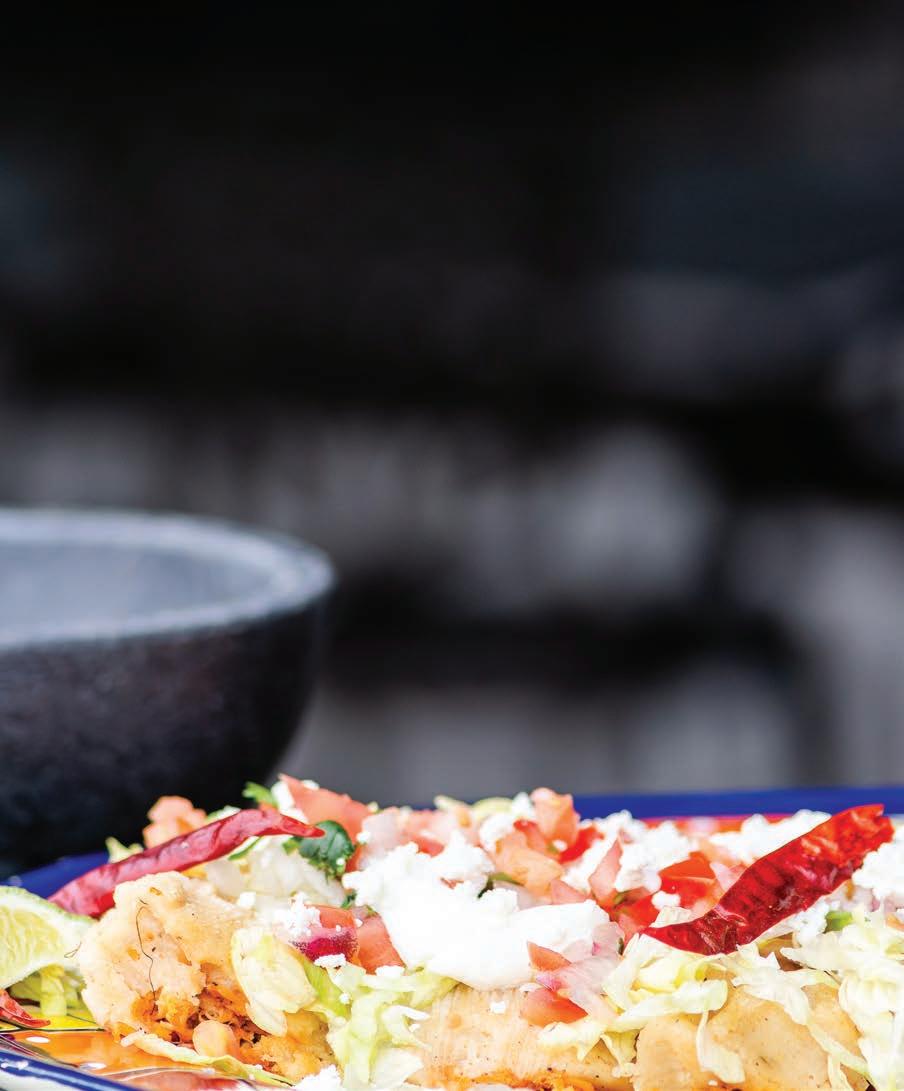



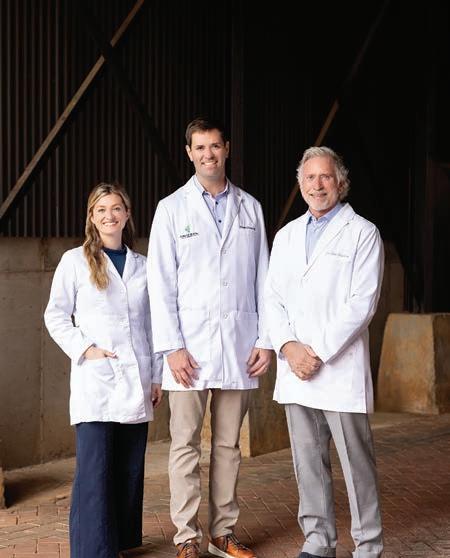









Volume 14, No. 11
“I have a fancy that every city has a voice.” www.ohenrymag.com
PUBLISHER
David Woronoff david@thepilot.com
Andie Rose, Creative Director andiesouthernpines@gmail.com
Cassie Bustamante, Editor cassie@ohenrymag.com
Jim Dodson, Editor at Large jwdauthor@gmail.com
Keith Borshak, Senior Designer
CONTRIBUTING EDITORS
Cynthia Adams, David Claude Bailey, Maria Johnson
CONTRIBUTING PHOTOGRAPHERS
Lynn Donovan, Amy Freeman, John Gessner, Bert VanderVeen, Mark Wagoner
CONTRIBUTORS
Harry Blair, Anne Blythe, Susan Campbell, Kay Cheshire, Jasmine Comer, Ross Howell Jr., Billy Ingram, Gerry O’Neill, Liza Roberts, Stephen E. Smith, Zora Stellanova, Ashley Walshe, Amberly Glitz Weber, Richie Zweigenhaft


ADVERTISING SALES
Lisa Allen
336.210.6921 • lisa@ohenrymag.com
Amy Grove
336.456.0827 • amy@ohenrymag.com
Brad Beard, Graphic Designer
Jennifer Bunting, Advertising Coordinator ohenrymag@ohenrymag.com
Henry Hogan, Finance Director

910.693.2497
Darlene Stark, Subscriptions & Circulation Director 910.693.2488
OWNERS
Jack Andrews, Frank Daniels III, David Woronoff
In memoriam Frank Daniels Jr.


















































































There’s no place like Greensboro
She does as told. (Modern technology can be a good thing, too!)
By Cassie Bustama Nte
In the age of streamable television and movies, some of my favorite childhood traditions have become a thing of the ’80s past: Saturday morning cartoons, singing commercial jingles on repeat with my brother — Who’s that kid with the Oreo cookie? — and annual movie marathons. Thanks to it being my father’s favorite festive film, our family always watched A Christmas Story during its 24-hour run on TNT. And for the longest time, the 1939 film The Wizard of Oz was an American Thanksgiving tradition more sacred than green bean casserole.
While I’m thrilled my three kids will never know the horror of “bagel bangs” and double-layered neon socks, it saddens me that some of these timeless treasures weren’t so timeless after all. But when we moved to Greensboro almost six years ago, I discovered that our little Emerald City had a November tradition of its own: the Community Theatre of Greensboro’s annual production of The Wizard of Oz.
Last year, our family, minus Sawyer, the oldest — an actual adult who claims musicals aren’t “his thing” — decided to partake in this community custom.
The day before our ticketed show, a Sunday matinee, 5-year-old Wilder and I are in the kitchen with roasted-potato-and-fennel soup simmering on the stovetop. Meanwhile, Chris, my husband, busies himself outside with leaf cleanup. “Alexa, play ‘Ding-Dong the Witch is Dead’ from The Wizard of Oz,” I command.
The melody, paired with squeaky, studio-altered munchkin voices, echoes throughout the kitchen. Wilder moves his little body to the music, but stops for a moment. A dimpled hand shoots to his mouth as he giggles at the chipmunk-esque sounds emanating from the speaker. After that song, Alexa continues with other tunes from the “Merry Old Land of Oz,” but Wilder is not into hearing what Dorothy or Glinda have to say. Nope, he only wants the music of his new fav singing group: The Munchkins.
The next morning, he wakes and asks immediately, “Is today the day? Are we going to The Wizard of Oz?” As the day progresses, the question becomes, “How many more minutes?”
Finally, it’s almost showtime. We park downtown and skip to the Carolina Theatre, where families pile in. I see little girls dressed up as Dorothy and sparkling shoes on feet of all sizes. I’ve donned my black “Bad Witch” sweater as a nod to poor, misunderstood Elphaba. (Hey, I’ve seen Wicked, too!) Wilder, meanwhile, wears his ruby red Nikes.
We find our seats in the center of the balcony. Wilder struggles to see, but doesn’t care for the feel of the plastic booster seat. I’m already a little concerned the show won’t hold his attention and now I’m worried he’ll be uncomfortable, too. “Do you want to sit on my lap?” I offer.
He snuggles in and anxiously awaits the start of the show. The music begins, the curtain opens and we see Dorothy and Toto — and yes, a real dog is cast in the role!
Wilder sits on the edge of his seat, aka my knees. He’s utterly enthralled. Next to me, my daughter, Emmy, and I exchange occasional smiling glances. Almost three hours pass and not once has he taken his eyes off the stage — minus an intermission potty break — unless it’s been to hide his face from the Wicked Witch of the West and her entourage of flying monkeys.
I’m hot and sweaty, regretting the wool sweater I’ve worn,
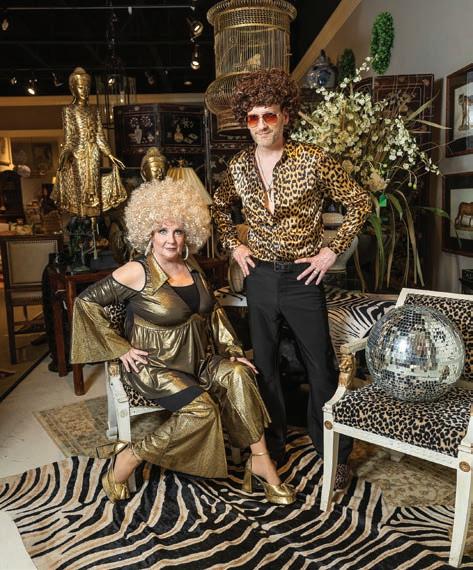


unaware that I’d be holding a human-sized space heater in my lap throughout the show, but I don’t care. Like those traditions I once thought timeless, these moments of borderline uncomfortable — but golden — closeness will similarly prove fleeting.
At the final curtain call, Wilder stands and cheers, whooping and hollering for the cast, especially the Tin Man. The Community Theatre’s executive director enters the stage to make some closing announcements, but our family takes that opportunity to beeline for the door before the crowd pours out. We can still hear
And just like that, it seems that a new-to-us tradition is born: Community Theatre productions.
her voice outside the theatre when she reminds the audience about next summer’s production of The Lion King Jr.
With his clammy little hand in mine, I drag Wilder hurriedly behind me, trying to catch up with Chris and Emmy. “Wait! Wait!” he shouts. “Can we see The Lion King?”
And just like that, it seems that a new-to-us tradition is born: Community Theatre productions.

“Of course we can,” I answer. While I am a parent who admittedly relies on YouTube and other digitally created content to entertain my children so I can accomplish tasks — or find a moment of peace, even — nothing can compare to the experience of real humans singing and dancing right in front of you. And while I don’t know how long his love of live theater will last, I plan to enjoy it while I can. Because this is the stuff of his own childhood memories. OH
Cassie Bustamante is editor of O.Henry magazine.




















By Jim DoDsoN
I decided that November is the most sacred month.
To my way of thinking, on so many levels, no other holds as much mystery, beauty and spiritual meaning as the 11th month of the calendar.
The landscape gardener in me is always relieved when the weather turns sharply cooler and there’s an end to the constant fever of pruning and weeding, plus fretting over plants struggling from the heat and drought of a summer that seems to grow more punishing each year.

newcomers, prefiguring catastrophe, have taken to cutting down their largest oaks as an extra measure of security in a world where, as actuaries and sages agree, there really is no guaranteed thing. In the meantime, the rest of us have made something of a Faustian bargain with these soulful giants for the privilege of living among them. We care for them and (sometimes) they don’t fall on us.
Speaking of “soul,” no month spiritually embodies it better than November.
Once the leaves are gathered up, and everything is cut back and mulched for the winter, not only does my planning “mind” kick in with what’s to be done for next year, but the beautifully bare contours of the Earth around me become a living symbol — and annual reminder — of life’s bittersweet circularity and the relative brevity of our journey through it.
The hilly old neighborhood where we reside is called Starmount Forest for good reason, owing to the mammoth oaks and sprawling maples that kindly shelter us with shade in summer and stand like druid guardians throughout the year, season after season. Beginning this month, the skies become clearer and the nighttime stars glimmer like diamonds on black velvet through their bare and mighty arms, hence the neighborhood’s name: a “mount” where the “stars” shine at night.
Of course, there is risk living among such monarchs of the forest. Every now and then, one of these elderly giants drops a large limb or, worse, topples over, proving their own mortality, sometimes taking out part of a house or a garage, or just blocking the street until work crews arrive with chainsaws. As far as I know, no one has ever been seriously injured or killed by our neighborhood trees, though the growing intensity of summer storms seems to elevate the danger. Lately, some neighborhood
All Souls’ Day, also called The Commemoration of All the Faithful Departed, comes on the second day of the 11th month, a day of prayer and remembrance for the faithful departed observed by Christians for centuries. The day before All Souls’ is All Saints’ Day, also known as All Hallows’ Day or the Feast of All Saints, a celebration in honor of all the saints of the church, whether they are known or unknown.
Every four years, the first Tuesday that follows the first Monday of November is our national Election Day, a day considered sacred by citizens who believe in the right to vote their conscience and tend the garden of democracy.
Congress established this curious weekday of voting in 1845 on the theory that, since a majority of Americans were (at that moment) farmers or residents of rural communities, their harvests would generally have been completed, with severe winter weather yet to arrive that could impede travel. Tuesday was also chosen so that voters could attend church on Sunday and have a full day to travel to and from their polling place on Monday, arriving home on Wednesday, just in time for traditional market day across America.
Like daylight saving time (which, by the way, ends Sunday, Nov. 3) some critics believe “Tuesday voting” is a relic of a bygone time, requiring modern voters to balance a busy workday with the sacred obligation of voting. For what it’s worth, I tend to fall
into the camp that advocates a newly established voting “holiday weekend” that would begin with the first Friday that follows the first Thursday of November, allowing three full days to exercise one’s civic obligation, throw a nice neighborhood cookout and mow the lawn for the last time.
While we’re in the spirit of reforming the calendar, would someone please ditch daylight saving time, a genuine relic of the past that totally wrecks the human body’s natural circadian rhythms? Farmers had it right: Rise with the sun and go to bed when it sets.
Next up in November’s parade of sacred moments is Veterans Day, which arrives on the 11th, a historic federal holiday that honors military veterans of the U.S. Armed Forces, established in the aftermath of World War I with the signing of the Armistice with Germany that went into effect at the 11th hour of the 11th day of the 11th month of 1918. In 1954, Armistice Day was renamed Veterans Day at the urging of major U.S. military organizations.
November’s gentler sunlight — at least here in the Northern Hemisphere — feels like a benediction falling across the leafless landscape, quite fitting for a month where we go “inside” literally and figuratively to celebrate the bounty of living on Earth. In the Celtic mind, late autumn is the time of the “inner harvest,”
when gratitude and memory yield their own kind of fertility.
“Correspondingly, when it is autumn in your life, the things that happened in the past, the experiences that were sown in the clay of your heart, almost unknown to you, now yield their fruit,” writes the late Irish poet John O’Donohue.
First shared by Squanto and the pilgrims in 1621, Thanksgiving was decreed “a day of public Thanksgiving and Prayer” on November 26, 1789, by George Washington. Then it was proclaimed a national holiday on the last Thursday of November by Abe Lincoln. Finally, during the Great Depression in 1939, it was moved to the third Thursday of the month by Franklin Roosevelt to extend Christmas shopping days. But for most folks, the observance of Thanksgiving embodies, I suspect, many of the things we hold sacred in life:
The gathering of families, memories of loved ones, lots of laughter, good food and friendly debates over football and politics. I give extra thanks for Thanksgiving every year, especially the day after when some who hold bargain-hunting on “Black Friday” a sacred ritual thankfully disappear and I am free to enjoy my favorite “loaded” turkey sandwich and take a nice long afternoon nap by the fire to celebrate my favorite holiday. OH
Jim Dodson is the founding editor of O.Henry.






"A spirited forum of Gate City food, drink, history, art, events, rumors and eccentrics worthy of our famous namesake"

We say “data boy” to Patrick Fannes, who freely offers his time and knowledge to turning tech trash into treasure. Caching a collection of Windows- and Mac-based tablets, laptops and desktop computers (no more than seven years old), Fannes wipes them clean of all private data, refurbishing as needed before placing them in the hands of disadvantaged children. Though he holds a degree in computer science, he says, “In life I am a lay, ordained Buddhist monk and a doctor of Chinese medicine, serving my community to make this world a better and kinder place.” His friends and associates call him Shifu, the Chinese word for master or teacher, a term of respect. Through Big Brothers Big Sisters, Shifu has worked to provide 200 computers over the last 15 years. If you have an old computer collecting dust, let him give it a second life. And don’t worry — “Your private data will be erased from the computer hard drive and a binary code will be written across the entire surface of the drive nine times so that retrieving any information is impossible.” By donating your tech trash, you’ll not only make your house and the Earth cleaner; you’ll be giving a local child the necessary tools to set them up for success in life. To donate, email Fannes: onecodebreaker@gmail.com.
As I’m writing this, most Americans are a lot more interested in who will be president than what sort of garden they’ll plant.
Not Marta McDowell, who penned All The Presidents’ Gardens in 2016. From George Washington to Barack Obama, she digs up the dirt, so to speak, about who had a perennial obsession with plants. George and Martha Washington, John and Abigail Adams, along with Thomas Jefferson, had gardens and ambitious plans for plants — before the British burned down the White House in 1814 (after the U.S. Army burned down what became Toronto). At the very least, presidents had vegetable gardens since expenses for family food and banquets came out of their own pockets.

James Monroe moved into a mansion under construction, inheriting a yard with the sort of mucky mess that accompanies reconstruction projects. It was John Quincy Adams, McDowell points out, who, faced with a tumultuous presidency and the death of his father, sought solace in, as he described it, “botany, the natural lighting of trees and the purpose of naturalizing exotics.” To give you an idea of what Adams had to work with, McDowell writes, “To keep the lawns at least roughly trimmed, he arranged for mowers with scythes to cut the long grass for hay, and sometimes borrowed flocks of sheep.” Adams did have a full-time gardener to help him, John Ousley, an Irish immigrant. Following a plan that the plant-and-garden-crazed Jefferson had drafted, the duo got down and dirty. Each morning, after a brisk swim in the nearby Potomac, Adams spent several hours in his garden to “persevere in seeking health by laborious exercise.” McDowell writes, “His was a garden of celebrated variety.” In the two acres he carved out, Adams boasted that you would find “forest and fruit trees, shrubs, herbs, esculent (edible) vegetables, kitchen and medicinal herbs, hot-house plants, flowers — and weeds,” he added, revealing how honest a gardener he was. Adams also collected white oaks, chestnuts, elms and other native trees with an environmental objective: “to preserve the precious plants native to our country from the certain destruction to which they are tending.”
As the latest occupant — and gardener — moves into the White House in January, may I suggest that McDowell’s book might serve as a soothing antidote to the inevitable drama of nightly news and daily headlines.
David
Claude Bailey

In Asheville author Robert Beatty’s latest book, Sylvia Doe and the 100-Year Flood, Sylvia Doe doesn’t know where she was born or the people she came from. She doesn’t even know her real last name. When Hurricane Jessamine causes the remote mountain valley where she lives to flood, Sylvia must rescue her beloved horses. But she begins to encounter strange and wondrous things floating down the river. Glittering gemstones and wild animals that don’t belong — everything’s out of place. Then she spots an unconscious boy floating in the water. As she fights to rescue the boy — and their adventure together begins — Sylvia wonders who he is and where he came from. And why does she feel such a strong connec tion to this mysterious boy?

Known for his Serafina series, Beatty will be donating 100 percent of his earned royalties from Sylvia Doe and the 100-Year Flood — a story he’s been writing for several years — to the people impacted by the catastrophic floods caused by Hurricane Helene in Asheville, North Carolina where he lives. The real-life 100year flood struck at the same time the book was scheduled to launch. (Ages 8 -12.)

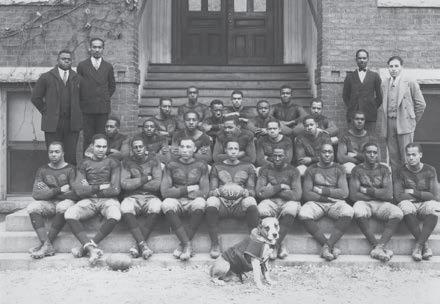
When the photographer says, "Look tough," but there's always that one guy who's trying not to crack a smile.
N.C. A&T's football team, circa late 1930s.

THIS YEAR, STIR UP SOME NEW HOLIDAY MEMORIES.
All throughout November and December, you’ll find holiday cheer in great abundance everywhere you turn in Alamance County. Picture postcard sights, sounds and celebrations immerse you in a magical backdrop that transports you to another place and time. Take in holiday concerts and Christmas events filled with entertainment, holiday treats, and traditions. Discover that perfect gift, bauble or decoration. And see the enchantment unfold before your eyes.
You’ll find small surprises lead to big memories in Alamance County.

As the season of hosting holiday gatherings enters stage left, you can bet your bottom dollar that online publications will be full of ideas for “conversation starters.” Case in point, Parade posted 250 last October, including questions you can ask to spark a connection, such as “What’s the nicest thing you’ve ever done for someone?” Well, since you asked, the nicest thing is what we’re about to do for you — provide you with conversation enders. Kenny Rogers was not wrong when he purportedly said you gotta “know when to walk away and know when to run.” But how do we just leave, Kenny? Here’s some helpful dialogue to practice in the mirror when you’re party-prepping.

“You seem like you’d be perfect for my team. How does a flexible schedule and company-paid luxury vacations sound? A new car? Let me tell you all about how I can help you find financial freedom so you can live the life of your dreams.”

(Look at Apple Watch or phone) “Sorry, I gotta take this — it’s my cat’s agent. By the way, follow him on Insta — @WilliamSydneyPurrter.”

(Cough, cough.)
“Don’t worry, I’m pretty sure it’s not RSV or SARS COVID-2.”




“Oh, my gosh, have you met Greg? People call him Greg-arious because, well, you’ll see!” (Introduce them and slowly back away.)

When all else fails, pull a travel-sized Glide out of your back pocket and start flossing your teeth on the spot, and then say “Oops, sorry about that,” as you wipe something off their cheek.




(October 23 –November 21)


Nothing like an old sweater, huh? So comfy and familiar. But so not doing you any favors. This month, self-worth is the name of the game. And here’s the thing: You’re destined to win. It’s simply a matter of ditching the security blanket — be that a threadbare sweater or an outdated (read, self-effacing) MO. Oh, and when Juno enters your sign on Nov. 3, get ready for a nextlevel soul connection. We’re talking oceanic depths. How do you feel about whale songs?
Sagittarius (November 22 – December 21)
Throw out the candy.
Capricorn (December 22 – January 19)
Get ready for a boon.
Aquarius (January 20 – February 18)
Turn the dial just a hair.
Pisces (February 19 – March 20)
More root vegetables.
Aries (March 21 – April 19)
Try softening your gaze.
Taurus (April 20 – May 20)
Just ask for directions.
Gemini (May 21 – June 20)
Lay off the caffeine for a bit.
Cancer (June 21 – July 22)
Someone’s got your back.
Leo (July 23 – August 22)
Get cozy with the silence.
Virgo (August 23 – September 22)
Worrying won’t help.
Libra (September 23 – October 22)
Don’t be a doormat. OH
Zora Stellanova has been divining with tea leaves since Game of Thrones’ Starbucks cup mishap of 2019. While she’s not exactly a medium, she’s far from average. She lives in the N.C. foothills with her Sphynx cat, Lyla.
• Offering safe & professional riding & driving instruction
• Brand new indoor riding arena
• Private or group lessons ages 6 & up
• Tiny tot lessons
Located approximately 15-20 minutes from most areas in Kernersville, Greensboro and Burlington areas
“No hour of life is wasted that is spent in the saddle.” Winston Churchill
5838 Thacker Dairy Rd Whitsett, NC 27377
Scheduling Phone Number: Call or Text 401-829-0863

Heritagestablesnc@aol.com | heritagestablellc.com
Owners: Bryan & Katy Earehart | Head Instructor: Hannah Sette



® dessessatsniaga


*Manufacturer’s mail-in rebate offer valid for qualifying purchases made September 7 - December 2, 2024, from participating dealers in the U.S. only. Offer excludes HDOrigins® and Nantucket™ Window Shadings, a collection of Silhouette® Window Shadings. Rebate will be issued as a Virtual Reward Card and emailed within 6 weeks of rebate claim approval. Subject to applicable law, a $3.00 monthly fee will be assessed against card balance 12 months after card issuance and each month thereafter. See complete terms distributed with Virtual Reward Card. Additional limitations may apply. Ask participating dealers for details and rebate form. ©2024 Hunter Douglas. All rights reserved. All trademarks used herein are the property of Hunter Douglas or their respective owners. Orders with more than 10 shades will only be awarded a rebate for the first 10 shades, for a total rebate cap of $750. Orders with fewer than 4 shades will not be awarded any rebate.
® dnatekcutnaN™a wodniW,sgnidahS
* .ylnoreffOsedulcxesnigirODH®dnatekcutnaN™a wodniW,sgnidahS c noitcelloetteuohliS®tsniagaelbacilppa,wala00.3$ylhtnomeeflliwdessessa c srelaedrofsliateddnaetaber.mrof © aetaberrofehttsrfi,sedahs lliwtondedrawayna.etaberf
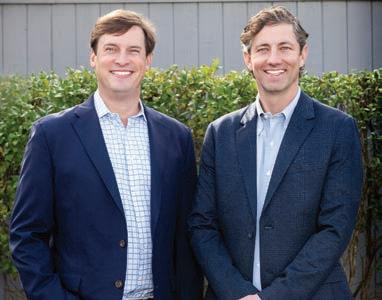





By m aria JohNsoN
I stopped at the snack display just inside the grocery store’s sliding doors.
A bank of pillowy bags promised pumpkin pie-flavored popcorn.
As my brain mulled the mingling of those flavors, a store clerk walked past me.
“I don’t know about that,” he muttered under his breath. He was right.
There was no reason to buy that bag when I had a jar of pop corn kernels, a stick of butter, a bottle of pumpkin pie spice and a bag of brown sugar at home. Smooth, sweet, salty, warm.


I would be making pumpkin-spiced popcorn soon.
A couple of decades ago, it wouldn’t have occurred to me.
That was before America jumped on the pumpkin-spicelatte train.
It began innocently enough, in 2003, in the Liquid Lab, a corner of Starbucks headquarters in Seattle. Charged with creating a new coffee drink, employees focused on a customer survey in which pumpkin kept popping up as a unique flavor.
So they did the natural thing: They spent hours eating pumpkin pie, sipping espresso and wondering how they ever landed such a cushy gig.
Eventually, they fused the flavors into one autumnal concoction and jotted down the recipe: espresso, steamed milk and pumpkin pie spices — basically cinnamon, nutmeg and ginger.
They called their invention Pumpkin Spice Latte, or PSL, and tested it in 100 stores in Washington, D.C., and Vancouver, Canada.
Customers on both coasts slurped it up, and Starbucks rolled out the PSL to a toasty reception nationwide, but it wasn’t until Facebook and Twitter took off in 2006 that PSL found its wings.
Ever since then, from September through November, we’ve been bonkers for pumpkin-spiced anything.
I didn’t realize just how much we’d normalized the gourd until I tootled down the aisles of Trader Joe’s last year and noted the following items:
Pumpkin hummus.
I clung to the vine, following it around the store, hoping it would lead me out of the orange storm. Which it did. But not before …
Apple-and-pumpkin hand pies.
Pumpkin brioche.
Pumpkin-maple-bacon dog treats.
Pumpkin pancake mix.
Teeny-tiny pumpkin-spiced pretzels.
Pumpkin oat beverage.
Pasta sauce with pumpkin and butternut squash.
Pumpkin cider.
Pumpkin ale.
Pumpkin ravioli.
Pumpkin gnocchi.
Chocolate mousse pumpkin candies.
Pumpkin-spice cookie batons.
Pumpkin Joe-Joe’s (a version of the Oreos knockoffs).
Pumpkin kringles (No worries, Santa. They’re coffee cake rings).
Pumpkin bisque.
And last but not least, pumpkin body butter, for skin as soft as a … jack-o-lantern?
Good grief! I hadn’t been so spiced out since I binge-burned a pack of patchouli incense as a young woman. The effect was intense, transcendent and lasting, meaning I never got the smell of hippie-fied tranquility out of my curtains.




What accounted for the persistent appeal of pumpkin spice? Was there any taste trend that could compete?
I called Michael Oden, the marketing manager over at Mother Murphy’s, a family-owned Greensboro company that ships food and beverage flavorings to 30 countries. Their products include pumpkin-spice flavorings for beer and liquor.
Michael is sanguine about the state of the squash.
“Pumpkin spice will always be here,” he says, explaining that the taste’s popularity rests on cultural conditioning. Once people associate certain flavors with holidays, they try more versions, which drives more products to shelves, which reinforces the link.
Call it a flavor loop. Or a Pumpkin O, if you like.
Hybrids are bound to develop, Michael says, citing the pumpkin-allied flavors of apple, caramel, maple and cranberry.
In the last few years, another flavor fusion — “sweet heat” or “swicy” — has brought us jalapeño spiked honey, ancho chili pecan pie, strawberry tarts with black pepper, cayenne-chocolate cookies and ice cream set ablaze with gochujang, Korean chili paste.
Michael expects pumpkin spice and Cousin Swicy to inhabit the American palate for at least another five years.
The trick, he says, is for tastemakers to keep their offerings seasonal and to keep the intensity of their flavorings proportionate to their serving sizes.
“There are things that become too much,” he says tactfully.
I thought of this a few weeks ago when I made pumpkinspiced popcorn at home. We were about to stream a movie when I pulled the Orville Redenbacher out of the pantry.
“Cover your eyes, Orville,” I said, pouring kernels into the well of the hot-air popper.
I melted butter, stirred in the sugar and spice, then drizzled the glaze over fresh popcorn and pressed “play” on the original Beetlejuice from 1988.
Somehow, we missed the multiplex mania back then and decided to revisit the phenomenon as a possible precursor to seeing the recently-released reprise, Beetlejuice Beetlejuice.
The original story was kinda fun. And pretty stupid. And very much a creature of its time.
I mean, Robert Goulet. Need I say more?
Oddly enough, our impression of my homemade pumpkinspiced popcorn followed a similar pathway, progressing quickly from mmm to meh to OMG, please make it stop.
We set our bowls aside and hit pause.
Whether it’s patchouli or pumpkin spice or a prison-striped pest from the Great Beyond, I’m here to tell you — three times if necessary — that a little goes a long way. OH
Maria Johnson is a contributing editor of O.Henry magazine. Email her at ohenrymaria@gmail.com.



Tickets and information at www.oldsalem.org
Wednesday-Saturday 10 a.m.-4 p.m.











By Stephen e. Smith
Astartling buzzing blasts from your phone or TV, followed by a high-pitched whine, and a detailed description of a missing child inching across the screen. It’s an active Amber alert — a child abduction emergency. We experience these alerts too often, but we rarely learn what becomes of the missing child or how such a disappearance affects the child’s family, friends and the community in which the child lives.
Marybeth Mayhew Whalen’s 10th novel, Every Moment Since, is a fictional exploration of the emotional forces that wear on those who knew and loved 11-year-old Davy Malcor, who went missing for over two decades. The narrative opens with an early morning phone call informing Sheriff Lancaster that Davy’s favorite jacket was found in an abandoned building near the small North Carolina town of Wynotte. The burden of Davy’s disappearance is still very much in the public consciousness, fixed there by a bestselling memoir written by Davy’s older brother, Thaddeus, who had been responsible for watching over Davy on the night he vanished. On that tragic evening, Davy’s parents were attending a cocktail party, and Thaddeus ditched Davy so he could drink beer with his buddies. Davy wandered in the darkness with a mysterious new friend until headlights flickered through the neighborhood and Davy was gone. What happened that night transformed the characters’ lives and, years later, one question haunts them all: What might I have done differently?

her time to advocating for the families of missing children. Thaddeus is profiting from his family’s misfortune with a bestselling memoir. Aniss Weaver, the last person to see Davy alive, works as a public information officer for the local police. Gordon Swift, a local sculptor, is the prime suspect in Davy’s disappearance, although there has never been adequate evidence to bring charges against him. We have all the ingredients for a suspenseful mystery.
But Every Moment Since isn’t your typical whodunnit. The plot is a trifle too straightforward: a boy goes missing, his family suffers, the community agonizes, a body is eventually found, and the mystery, albeit a slight one, is solved. There are too few plot twists or complications in the early stages of the narrative, and much of the expository information in the first 180 pages of the 363-page novel focuses on the minutia of the characters’ day-to-day lives. Throughout the story, there is a nagging need to “bring on the bear.”
Whalen’s focus, the moving force in the novel, is guilt, which the characters suffer to various degrees. Tabitha rebukes herself for having left Davy in Thaddeus’ care so she could spend an evening socializing. Aniss Weaver is troubled by her specific knowledge that Thaddeus is blameless. And Thaddeus, more than any of the characters, is troubled by the financial success of his memoir about his brother’s disappearance. Gordon Swift, although innocent, suffers from doubts about his sexuality and the community’s suspicion that focuses on him as the likely culprit.
Whalen has provided an intriguing cast of characters. Tabitha, Davy’s mother, is divorced (a byproduct of her son’s disappearance) and lives alone in the house where Davy was raised. She devotes
Whalen employs various third-person points of view that are not arranged chronologically (think Pulp Fiction). And the chapters range from excerpts taken from Thaddeus’ memoir to Tabitha’s daily bouts of regret to pure narrative segments that nudge the story forward. Even Davy, who has long since disappeared from the immediate action, has a third-person limited view in parts of the novel.












If this sounds like a lot to keep straight, it is, and the reader is required to focus his or her attention on what is happening to whom and when. The only question that needs answering is why the narrative is presented in this disjointed fashion, which becomes apparent in the novel’s final chapters.
The reader might reasonably conclude that the novel was written with the audiobook in mind (available as a digital download through Kindle). Chapters featuring the various personas written in the limited third person achieve degrees of separation and distinction when read by voice actors representing the various characters. For example, book chapters about Tabitha contain too few distinctive hooks that the reader can employ to establish an ongoing connection with the character, and one’s attention must remain fixed on who is doing what and when. Read aloud, the connection is immediate and continuous.
Every Moment Since is not recommended for anyone suffering from ADHD or for casual readers who will likely put the novel aside for days and expect to pick up the narrative line without rereading. The shifting points of view will not detract from the novel’s impact if the reader remains focused.
Whalen creates believable characters and has a true talent for dialogue — and she is to be congratulated for taking on a challenging and complex subject. The disappearance of a child is a horrifying possibility for any parent, and the crippling emotions suffered by a family that has experienced such a loss are almost inconceivable. Every Moment Since is a reminder that we should take careful notice of the Amber alerts that come blaring across our TVs and phones. They aren’t works of fiction. OH
Stephen E. Smith is a retired professor and the author of seven books of poetry and prose. He’s the recipient of the Poetry Northwest Young Poet’s Prize, the Zoe Kincaid Brockman Prize for poetry and four North Carolina Press Awards.

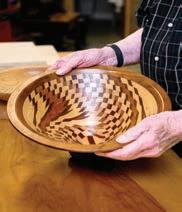
As highly skilled woodworkers, Carl and Karl love making things—furniture, bowls, jewelry, and more. Now, thanks to their efforts to bring a new fully-equipped and stand-alone woodshop to Arbor Acres, the men have a dedicated place to work and share with other residents. “We have a full collection of high-quality tools,” says Karl. “And safety is a key feature,” Carl adds, referring to detailed training sessions. Arbor Acres is happy to continue fulfilling the visions of our residents, who continue to make this place alive with their creative energy.





memoir By K ay CheShire
Note from the editor: This story won third place in our 2023 O. Henry Essay Contest


“There’s one in every crowd,” I heard someone in line say.
Just as the girl was about to help this customer, the mink-coated woman broke in line again, this time with a tree-shaped platter.
“Do you have a box for this?”
Long before online shopping was invented, everyone relied on newspaper ads for sales. Many years ago, a week before Christmas, one of our city’s large department stores advertised Christmas china and accessories for sale, and when the ads came out, so did the shoppers.
The china department was crowded with last minute bargain hunters admiring mugs with reindeer handles, Santa cookie jars and star-shaped serving platters. I found the perfect red bowl, decorated with snowflakes for my Christmas buffet, and joined the long checkout line. There was only one salesclerk, a young woman, doing her best to keep the line moving.
While waiting, I chatted with the women in front of and behind me in line. We discussed the weather, what toys kids wanted and how the holidays came faster and faster each year. I complimented the well-dressed woman in front of me on her beautiful green wool suit.
“I only wear it during the holidays. It’s so old,” she said, laughing.
As we inched our way to the checkout counter, more and more customers joined the already long line, now quite long. I wondered why the store hadn’t hired more people to help.
When only one woman was ahead of my new friend in the green suit, an older women in a mink coat with plaster-sprayed hair barged in front of her and asked the salesgirl, “Do you have more reindeer mugs in the back? I only see four and I need eight.”
“I’m sorry, all the sale items are out on the table.”
“There’s always more things in the back, you just need to check,” the woman insisted.
“There are no other holiday items in the back,” the salesgirl replied. “My manager said everything was out for the sale.”
The mink-coated woman huffed, but wordlessly walked away. The young salesgirl apologized to the customer for having to wait.
“We don’t have boxes here,” the salesgirl answered. “You need to go to gift wrapping on the first floor.”
“I don’t mean a gift box. I mean, did this platter come with its own box?”
“They didn’t come with individual boxes; the platters were shipped as a group.”
“What kind of store is this?” the woman blurted out, walking away.
As the woman in front of me in the green suit finally made it to the cashier counter, the mink-clad woman interrupted a third time, with a white plate.
“I need eight of these and I know you have more in the back because these are not on sale.”
The young girl replied, “As soon as I finish with these ladies who have been waiting in line, I’ll be glad to help you, but I can’t leave right now.”
The mink woman said, “I’m good friends with the general manager of this store and I think he needs to hear that his salesclerks are slow and rude.”
“The woman behind me whispered, “She needs to look in a mirror to see rude.”
The green-suited lady said to the interloper, “Do you also know the wife of the general manager?”
“Yes, of course.”
“Well, I’m meeting her for lunch so tell me your name. If I’m late because you prevented this young woman from doing her job, she’ll know why.”
The mink coat shook as the woman slammed the plate down. Storming away, she shouted, “Tell her the salesclerk in china needs to be fired.”
“This young lady is exactly the kind of employee this store is lucky to have,” my new friend answered.
“Do you really think I’ll get fired?” the young girl asked.
“Of course not. I doubt she knows the general manager. She just made that story up, thinking you would be intimidated.”
“I really need this job. I know I’m slow, but there was sup -

& NEWS
• LUCKY 32: LUNCH & DINNER 6 DAYS (Closed Mon.) (BRUNCH Sat. & Sun.)

• O.Henry LIVE JAZZ! Every Thursday from 6-9 PM and Select Saturdays from 7-10 PM in the Social Lobby. See the schedule at ohenryhotel.com
• LIVE Music at L32! The party’s moved to Lucky’s! AM rOdeO (Jessica Mashburn & Evan Olson) 6-9 PM lucky32.com
• Romance Packages at O.Henry & Proximity Book online at ohenryhotel.com or proximityhotel.com
• Artist-in-Residence Chip Holton at L32! Live painting Wednesday – Sunday 12-2 PM and 6-8 PM. Stop by!! lucky32.com

• Weddings | Meetings | Retreats | Events | Group Accommodations Learn more ohenryhotel.com or proximityhotel.com
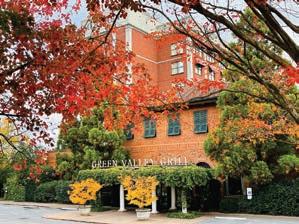


posed to be two of us until the other woman called in sick. I told the manager I could handle this by myself, but it’s having to wrap each piece of china in plain newsprint before bagging that makes me so slow.”
“We can do that for you, can’t we girls?” the green-suited woman said, turning towards me and the woman behind me.
“Oh no, I can’t let you do that,” the salesgirl said, horrified. “I’ll get fired for sure. Besides, you’re having lunch with the wife of the general manager.”
“You won’t get fired. Just tell anyone who asks that we’re your volunteer Christmas elves helping out today. And I am not having lunch with anyone. I can tell a whopper of a story as good as the woman in her mink!”
We paid for our items, then stood behind the salesclerk. The three of us started wrapping each customer’s purchases. After an hour, the sales table was empty, and all the shoppers were happily wishing us a Merry Christmas.
“Thank you all so much. I don’t know what I would have done without you three ladies. You’re definitely my Christmas angels.”
I’m not sure “angels” would describe us, but if it hadn’t been for the courage of the woman in the green suit, customers would have been upset over the long wait, and the young salesgirl indeed may have lost her job. I learned — and maybe we all learned that day — how the spirit of kindness from just one person can create a ripple effect, inspiring those around her.
A week later, there was a picture in the newspaper of the general manager of that store and his wife attending a charity New Year’s Eve party. There she was, the lady in the green suit, whose kindness had organized us to help the young salesgirl. She certainly could tell a whopper of a story. OH
Kay Cheshire has been a Writer-in-Residence at the Weymouth Center in Southern Pines. She and her husband, Ed, live in Greensboro.
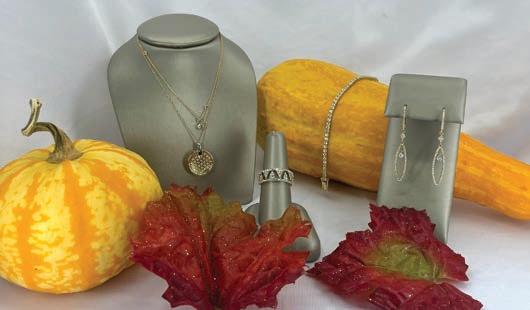






The sunset days of an elderly neighbor

By Cynthia a damS
EthelDavis questioned my pen and notetaking.
“I’m a retired English teacher,” she said, eyes sharp. “Mrs. Davis.” Pause. “And you are?”
So began a friendship lasting well beyond a community project that brought me to her door. A year later, she asked that I help with ending her life.
Mrs. Davis lived near the 1911 house we were reviving. Her own home was in a death rattle. Leaves idled on a rickety porch. Inside, paint peeled from the ceilings, surrendering to the tropical heat she preferred. Rugs, curtains, and upholstery dry rotted.
Mrs. Davis and her house were aging in sync. Her bony elbows jutted through a sweater which she pulled closer as I shucked mine off.
When I brought clothing, she protested. “But, my dear, I have so many beautiful clothes!” I brought food, too, which she accepted protesting, “Oh, Mary could prepare something.”
“Mary?”
“My housekeeper.” Having never seen another soul in the house, day nor night, Mary was either a ruse or imagined helpmate. My heart twisted at her fierce pride.
I grew increasingly anxious for the feisty 95-year-old. The mysterious “Mary” had just left or was late, according to Mrs. Davis, who subsisted upon Campbell’s soup. A sleeve of Ritz crackers sat alongside crossword puzzles, pencil stubs, paper clips, rubber
bands and an ancient flash light.
If I brought treats, she insisted, “I’ve plenty, my dear.” Mrs. Davis had a well-supplied imagination.
“My sweet Herman visited last night! He stood right there!” She mentioned nocturnal visits from a long dead sister, too. These apparitions comforted her while alarming me. Was the membrane between life and death dissolving?
Reciting Tennyson’s “Crossing the Bar,” she taped it to her headboard, warbling, “Sunset and evening star, and one clear call for me!”
Whenever she didn’t answer, I circled outside, calling her name. One autumn afternoon, colorful leaves fluttering onto her porch, Mrs. Davis peered from a cloudy window as I arrived unannounced.
“My dear,” she asked in her mannered way, “could you possibly take me banking?” Donning an ancient wool coat and dishwater gray scarf, she carried a clutch purse dated to the Eisenhower administration.
Entering the bank, she trilled “Hello, Helpers!” pulling out a passbook wrapped by 10 rubber bands.
An eager banker bounded up. “Let’s go to my office!”
Discombobulated, I mumbled, “I’ll wait.” She reemerged, regal, like the aristocrat she was.
We crisscrossed Friendly Shopping Center, where banks safeguarded the widow’s wealth. “My Herman always said, ‘Count the pennies and the dollars take care of themselves.’” She patted the purse filled with passbooks. “My daughter wants her hands



home grown on his money.”
Mrs. Davis had a daughter?


“I love giving patients a reason to smile while focusing on education and comprehensive dental care.”
-Dr.TariqJah
DR TARIQ JAH, DDS
soup and water, inquiring if crackers were for $1.99! Or, would you prefer an alarm
“My dear,” she ventured mid-spoonful, “I’ve decided I’m ready to join Mr. Davis.” ? Look, Silence. I circled the house. Nothing. Mrs. Davis finally answered her ancient rotary phone, murmuring, “Sorry, dear, I was in
cussed her ghostly visitors — never again mentioning euthanasia.
One afternoon she failed to answer the doorbell or my phone calls. After a sleepless night, I went to a neighbor. Her daughter had arrived the prior morning in a U-Haul, collecting a visibly upset Mrs. Davis and some furniture. No number. No forwarding address. And may there be no sadness of farewell, When I embark.
Leaves, darkening with mildew, cluttered her porch alongside fliers advertising Danish cookies and alarm clocks. I paused there on walks as dinner smells wafted through the neighborhood and stars blinked on.
Sunset and evening star, I mouthed softly. Winter deepened. And mysteries, too, of life or its absence. OH
Cynthia Adam is a contributing editor to O.Henry magazine.



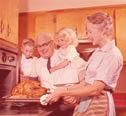
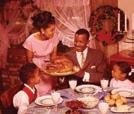












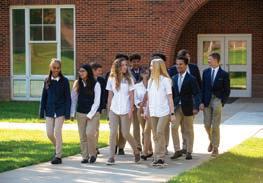



















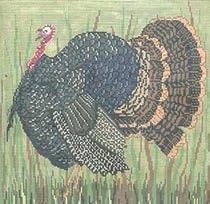





The subtle beauty of the hermit thrush

By SuSan CampBell
temperature and leaves drop, many birds return to their wintering haunts here in the Piedmont of North Carolina. After spending the breeding season up north, seedeaters such as finches and sparrows reappear in gardens across the area. But we have several species that are easily overlooked due to their cryptic coloration and secretive behavior. One of these is the hermit thrush. As its name implies, it tends to be solitary most of the year and also tends to lurk in the undergrowth.
However, this thrush is one of subtle beauty. The males and females are identical. They’re about 6 inches in length with an olive-brown back and a reddish tail. The hermit has brown breast spots, a trait shared by all of the thrush species (including juvenile American robins and Eastern bluebirds, who are familiar members of this group). At close range, it may be possible to see this bird’s white throat, pale bill and pink legs. Extended observation will no doubt reveal the hermit thrush’s distinctive behavior of raising its tail and then slowly dropping it when it comes to a stop.
Since one is far more likely to hear an individual than to see one, recognizing the hermit thrush’s call is important. It gives a quiet “chuck” note frequently as it moves along the forest floor. These birds can be found not only along creeks, at places like
Weymouth Woods and Haw River State Park, but along roadsides, the edges of golf courses and scrubby borders of farms throughout the region. It is not unusual for birders to count 40 or 50 individuals on local Audubon Christmas Bird Counts. However, they feed on fruits and insects so are not readily attracted to bird feeders. Over the years, I’ve had a few that managed to find my peanut butter-suet feeder, competing with the nuthatches and woodpeckers for the sweet, protein-rich treat. This tends to be after the dogwoods, beautyberry, pyracantha and the like have been stripped of their berries.
During the summer months, hermit thrushes can be found at elevation in New England and up to the coniferous forests of eastern Canada. A few pairs can even be found near the top of Mount Mitchell here in North Carolina (given the elevation) during May and June. The males have a beautiful flute-like song that gives them away in spite of their camouflage. They nest either on the ground or low in pines or spruces, and mainly feed their young caterpillars and other slow-moving insects.
As with so many migrant species, these thrushes are as faithful to their wintering areas as their breeding spot. I have had several very familiar individuals over the years along James Creek. Keep in mind that if a hermit thrush finds good habitat, he or she may return year after year. With a bit of thick cover, water not far off, and berries and bugs around, there is a good chance many of us will be hosting these handsome birds over the coming months — whether we know it or not. OH
Susan Campbell would love to receive your wildlife sightings and photos. She can be contacted by email at susan@ncaves.com, or by calling (910) 585-0574.
















By Billy ingram
For 30 years, beginning in 1950, Otto Zenke was one of the nation’s most respected interior designers. Based in Greensboro with offices in Palm Beach and London, he created spectacular environments for the finest homes along the East Coast including the mansion of the late Julian Price in Irving Park and Reynolda House in Winston-Salem. A year from now, however, a major portion of Zenke’s legacy will be erased forever when his former home and showroom is demolished for a parking lot.
Bridging the lifestyle gap between the old and new South, Zenke lent his 18th-century-influenced stateliness to residences surrounding golf courses in Pinehurst; country manors in Virginia and South Carolina; seaside abodes in Palm Beach; estates in Newport and Los Angeles; and homes appearing on covers and in photo spreads for House Beautiful and Architectural Digest. “Elegance and beauty were his trademark,” declared
Connoisseur magazine.
Georgian fireplaces, cut-glass chandeliers hung from high ceilings, gabled archways and boldly carved pilasters were just a few of Zenke’s signature touches. For select clients, lavishly illustrated, hand-painted murals of pastoral splendor or sprawling foxhunting scenes and delicately rendered chinoiserie panels adorned dining and living room walls. It’s doubtful most of those murals survive today but I’d heard rumors that one was extant, oddly enough, in the Guilford County Sheriff’s office.
In 1968, Zenke constructed a 3,000-square-foot home and showroom on the corner of Washington and Eugene Streets after the city had appropriated — by eminent domain — his extraordinarily beautiful residence and workspace across Eugene for use as the Governmental Center. The L-shaped English Regency-style complex he developed in ’68 was joined to, and fronted by, a twostory, New Orleans-inspired dwelling built in the late-1800s, one of the oldest houses still standing in downtown Greensboro.
After Zenke’s death in 1984, the county purchased the property and, today, within those hallowed walls, Guilford County Sheriff Danny H. Rogers presides over one of the largest sheriff’s offices in the state with 557 employees split between operations and detention bureaus.




Elected in 2018, Rogers is Guilford County’s first Black sheriff. Growing up in High Point in the 1960s, the few

African American law enforcement officers that existed locally were an inspiration to the very young Rogers, who learned by observing them — both how to interact with people and to “be who I am.”
In 1985 Sheriff Jim Proffitt allowed Rogers to work as a non-sworn detention officer. “The county had frozen the positions for sworn officers. Well, on my first day as a non-sworn detention officer, there were two of my white counterparts and they were sworn. I asked, ‘How long have you guys been here?’ Turns out their hire dates were the same as mine. I questioned it. I worked with the sheriff’s office for a little over a year and a half, then I went to the High Point Police Department, where they gave me an opportunity to be sworn and paid me to go to school. I was there for a little over three and a half years before coming back to the sheriff’s office.” After another three years or so, he was released from the department; it wasn’t until roughly 25 years later that he ran for and became sheriff for Guilford County.

During his time away from the sheriff’s office, Rogers earned a master’s degree in criminal justice and a theology degree. An open Bible sits on a shelf behind his desk. “I had a chance to understand the community from a different perspective,” Rogers says about his well-spent time away. “Getting out there, meeting the

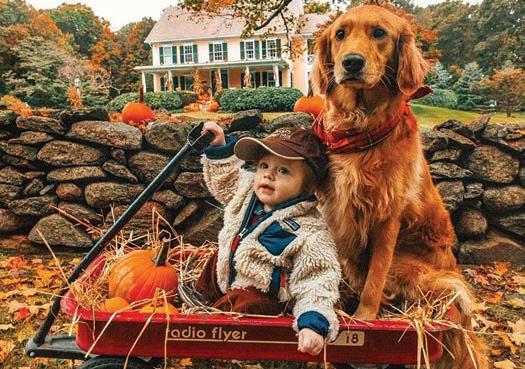






people and walking the streets was key when I first started.”
Whenever a new administrator takes over an organization, pushback inevitably follows. “There’s always a lot of behind the scenes conversation,” Rogers says about the transition after becoming sheriff. Those who want to stay will stay. Those who want to leave will leave.
“A positive change began within myself,” Rogers says. “But the real positive change began in the mindset of the men and women who work here, so they can go out in the community and help bring about that positive change. And it’s working. It’s not working like a grand slam or the perfect engine, but it’s working at the pace that it needs to.”
Naturally, I was curious to have a look around Zenke’s former showroom, imaging what you might see on modern TV police dramas, when detectives paste photos of hapless victims on the walls with a cat’s cradle of string tying them to
have been more mistaken.
Rogers’ office, once the designer’s living room, is enshrined in 130-year old wood paneling embedded with 15-foot high, built-in floor-to-ceiling bookcases framed in intricately carved crown molding. The bathroom is equipped with an unused sunken marble tub.
Zenke’s stylistic fingerprints are everywhere throughout this palatial domain: entranceways topped with half-moon transom windows; individually painted tiles in the kitchen; a restroom swathed in emboldened Asian-flavored floral wallpaper — all in pristine condition after more than half a century. Touring these offices a few years ago, one former North Carolina chief executive remarked that it was nicer than the governor’s mansion.
Surrounding the largest open space, to my delight and surprise, unscathed and perfectly preserved, was a panoramic hand-painted mural replicating the verdant patio of an Italian villa opening to


cally rendered black urns perched on either side. Nearly hidden in one corner, a peasant boy is relieving himself in the bushes, a naughty detail Zenke no doubt delighted clients with privately.


Atop another room’s mahogany bookcase is a marble inlay centered by a nobleman’s face. It has an unintended design element — a pronounced bullet hole piercing an interior glass door, shattered three years ago after gunfire erupted across the street. Soon after, all exterior windows were made bulletproof.
After visiting Zenke’s former digs, photographer Lynn Donovan and I were chatting as she packed cameras into the trunk of her car. A female detention center deputy stopped to question what a couple of suspicious-looking customers like us were doing meandering in the parking lot. “Oh, we’re here to shoot the sheriff,” I replied. That wasn’t a smile crossing the deputy’s lips as one hand inched closer to her baton. Donovan explained that we just wrapped up a photoshoot with the county’s top lawman. While we had, in fact, shot the sheriff, after the jailer moved on Donovan noted, “we did not shoot the deputy.”
After completion of the new Guilford County Sheriff’s Law Enforcement Administration Building in 2025, Otto Zenke’s former home/showroom next door will be demolished for a parking lot — naughty peasant boy and all. OH
A collection of Billy Ingram’s Greensboro musings, Eye on GSO, can be purchased in bookstores or at Amazon.com.









He looked like an old man hunkered down in a faded blue overcoat, his collar turned up, shoulders hunched. He didn’t seem bothered by the shallow water his feet were covered by, nor the chill winter air blowing around his bare pate. But then his narrow head rose like a periscope, higher and higher — swiveled in the direction of a hardly perceptible splash.
Slowly, he moved toward the sound on legs as skinny as walking sticks, to the place where dinner was served and eaten so fast, any cook would wonder if he tasted it. It was enough, however, to restore his quiet contemplations.
Hunger sated, he curled his long neck into its warm collar, and stood as still as a painting while the sun sank and the snow moon kept rising like a white balloon over the darkening lake, the stark tree branches, and a lone heron blending, bit by bit, into the blue light of dusk.

Terri Kirby Erickson is the author of seven collections of poems, including Night Talks: New & Selected Poems, which was a finalist for the International Book Award for Poetry.

Gather ’round the table and serve up one of Greensboro’s global chefs’ favorite dishes
By Cassie Bustamante • PhotograPhs By a my Freeman
In the spirit of celebratory feasts, we asked four local chefs — whose roots lie elsewhere around the world — to share a dish that’s a favorite around their own family tables. With so much to be grateful for in the Gate City, our bellies are especially thankful for the rich diversity of world-class hospitality and global fare available without having to travel far.
“Food is a symphony,” says Embur chefowner Jorge Castillo. “Everything that is in the dish, you have to put together in order to feel that.” Castillo, who trained at the Culinary Institute of America’s New York campus, originally hails from the Peruvian coast, where fresh seafood is abundant. “You ever sit with Peruvian people?” he asks. “They eat!” And much of what they eat is a JapanesePeruvian fusion cuisine known as Nikkei. His youngest daughter, Jennifer, who is working with her father until she attends law school next year, notes that Peru is home to a large number of Japanese immigrants who have influenced the culture. This dish, homemade Peruvian Nikkei-style fish, is a blend of veggies — snow peas, zucchini, peppers, Napa cabbage and bean sprouts — paired with fish and rice. When the smell of Castillo’s homemade sweet-and-sour sauce bristling with fresh spices tickles her nose, Jennifer says, “Oh, there’s about to be a big ol’ feast here!”

12-ounces white fish fillet
(Chef Jorge recommends grouper)
3/4–1 cup broccoli, chopped
1/2 cup cauliflower, chopped
1/2 cup green beans (cut into thirds)
1/2 cup snow peas
1 green bell pepper, chopped
1 red bell pepper, chopped

2 cups Napa cabbage, chopped into small pieces
1 handful of bean sprouts
1 teaspoon fresh minced ginger, divided
1 teaspoon minced garlic, divided
1 tablespoon oyster sauce, plus more for drizzling
1/2 tablespoon soy sauce, plus more for drizzling
1–1 1/2 tablespoons olive oil, plus more for drizzling
1 teaspoon sweet and sour sauce
1 teaspoon sesame oil
Salt and pepper, to taste
Red chili flakes, to taste
1 cup any choice of cooked rice (white rice preferably), divided into two servings
Directions:
Preheat the oven to 375 degrees Fahrenheit.
Bring a large pot of lightly salted water to a boil. Once the water has started boiling, add the broccoli and cauliflower and cook for about two minutes. (If using green beans instead of snow peas, boil them now as well). Then remove the broccoli and cauliflower, place into an ice water bath and set aside. After a few minutes, drain the water. Cut the 12-ounce fish fillet into two pieces. Place in a bowl and add salt, pepper, 1/2 teaspoon of minced ginger and 1/2 teaspoon of garlic. Drizzle equal parts of soy sauce and oyster sauce, and then add olive oil.
Heat a large nonstick pan over medium heat. Place the seasoned fish on the pan. Cook until lightly golden-brown on one side, about two minutes. Turn the fish over and repeat to the other side. Place the fish in a baking dish or keep in oven-safe pan.
In the preheated oven, bake the fish in the oven for about five minutes. (Time can vary depending on fish used, but the internal temperature should be 135 degrees Fahrenheit).
Meanwhile, in a separate pan, heat about 1–1 1/2 tablespoons of olive oil in a large pan over high heat. Add the bell peppers and snow peas (or prepared green beans if used). Sauté for 30–45 seconds and then add 1/2 teaspoon of minced garlic.
Once the garlic is lightly golden, add the cauliflower, broccoli, Napa cabbage and bean sprouts to the pan with the bell peppers and snow peas/greens beans. Sauté for another minute.
Add 1 tablespoon oyster sauce and 1/2 tablespoon soy sauce to the vegetables and toss together.
Remove the pan from heat. Add sweet and sour sauce, sesame oil and red chili flakes. Toss and set aside.
Divide fish among two plates, top it with the vegetables and serve with choice of rice.
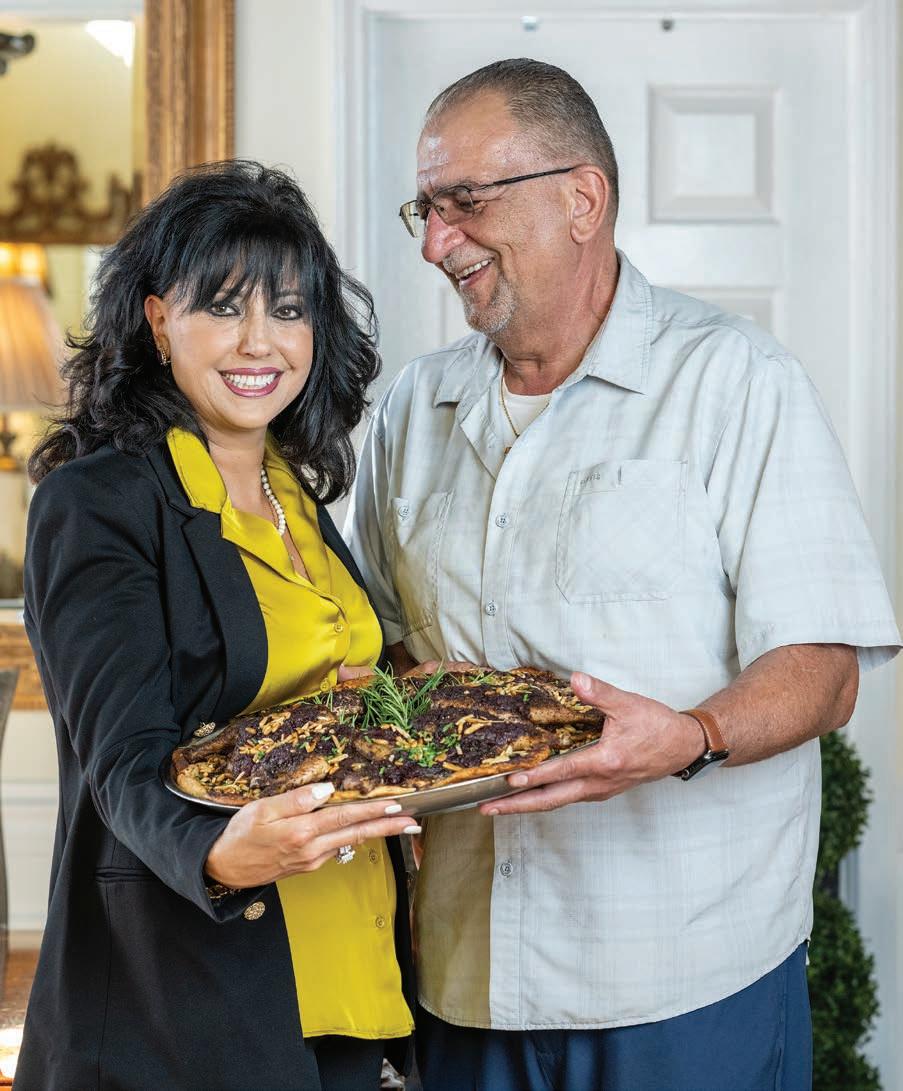
“My sister-in-law, who is American, calls this purple chicken,” says Ginah Soufia. A first-generation Palestinian American, Gina has owned Wallstreet Deli & Catering for 26 years with her Palestinian-born husband, Mike. “The aroma . . . it takes me back to my childhood,” she says, recalling the scent of sizzling, sumac-infused onions and goldentoasted pine nuts that drifted through the modest three-bedroom home. The table was always loaded with food and family — three generations living under one roof. To this day, she believes in setting a longer table to make room for others. “The great thing about the Palestinian culture is our hospitality — it is unmatched.” Musakhan, the national dish of Palestine, is often prepared at home by Ginah, with Mike — “the baker” — making the flatbread, Taboon, which sops up the flavor. What tradition does she hope to pass on to her own three grown children? “I want my kids to know that no matter what, your family will be there for you,” she says. “No matter what, your family is your family.”
Without chicken:
8 large red onions, medium-chopped
2 cups extra virgin olive oil
Chicken bouillon powder, to taste
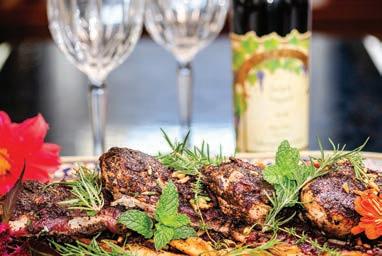
1/3 cup good-quality sumac (a bright-red spice made from ground dried sumac berries), plus more for sprinkling
6 Taboon or plain naan bread pieces
Pine nuts, fried or roasted
With chicken (same as above, plus):
3 small chickens
1/4 cup olive oil
1 tablespoon sumac
1 tablespoon seven spices
1 tablespoon ground coriander
1 tablespoon garlic powder
2 tablespoons salt
Without chicken:
Heat olive oil over low heat. Add onions to pan and sauté. Keep mixing until the onions become soft, have a bright pink color to them and have released all their water.
Continue to mix and add bouillon powder and sumac.
Spread onion mixture on each piece of bread and sprinkle with pine nuts and a little more sumac. Repeat and layer as you go, creating a stack.
With chicken:
Preheat oven to 450 degrees Fahrenheit.
Cut each chicken into either two halves or four pieces. Pat dry with paper towel.
Mix the olive oil and spices in a small bowl then brush on chicken from all sides. Place on a baking sheet lined with parchment paper, allowing room between each piece of chicken.
Cover with aluminum foil and bake for about one hour, then uncover and bake an additional 5–10 minutes until the skin is crispy and golden-brown.
Follow steps 1–3 from the vegetarian version above. Layer as many pieces of bread and onion mixture as you’d like, followed by a piece of chicken on top. For a single serving, one piece of bread topped with onions and one piece of chicken is recommended.

Born and raised in Turkey, Cugino Forno Pizzeria co-owner Joseph Ozbey has fond recollections of family meals centered around Lahmacun, aka Turkish pizza. “Every time I have this dish, it reminds me of our Sundays when I was a little kid.” Armed with the toppings his mother had prepared and some pocket change, Ozbey would go to the local baker, who would put the topping on crusts and bake. When Ozbey returned home with the fragrant, steaming Lahmacun, the table would be prepared — with salads, herbs, tomatoes, yogurt drinks — and the family would eat together. Soon, God willing, he will have a few of his own little ones sitting around the family table and he can share the rich history of his Turkish heritage. “Even a simple dish,” he says, “reminds you of your culture, reminds you of your roots.”

For the crust:
2 cups all-purpose flour
2 teaspoons kosher salt
1 1/2 teaspoons cane sugar
2 teaspoons dried instant yeast
1 2/3 cups water
For the topping:
1/3 cup small red bell pepper
1/2 cup onion
1/3 cup parsley
2 cloves garlic
1 teaspoon dried oregano
1/2 teaspoon dried mint
1 teaspoon cumin
1/4 teaspoon black pepper

2 tablespoons Turkish red pepper paste (can substitute tomato paste with a dash of hot sauce)
1/2 pound ground beef
For the crust:
Combine all of the dry ingredients in a large mixing bowl. Whisk together. Add the water and fold and mix until a ball of dough forms. Allow to rise for about one hour.
Transfer the dough to a floured surface. Cut the dough into six even pieces. Shape each piece by hand and then use a rolling pin to create a thin circular shape. (Add additional flour to the surface, to your hands and to the rolling pin when necessary.)
For the topping:
Fine-dice the red peppers and onion, mince the garlic and finely chop the parsley. Aim for tiny pieces of everything — the tinier, the better. Add the chopped and minced ingredients, the rest of the seasonings and the red pepper paste to the ground beef. Massage and mix with your hands for no less than five minutes,
Evenly spread the meat mixture on your prepared crusts. Bake for 20–25 minutes in an oven preheated to 350 degrees Fahrenheit.

Aurelio Ruiz and daughter Alondra Ruiz Fowler,
Kiosco Mexican Grill
“Every tamale is different,” says 25-year-old Alondra Ruiz Fowler, eldest daughter of Kiosco owner and chef Aurelio Ruiz. “Every family makes them differently.” Her own grandmother, who lived with them when Fowler was a child, still, to this day, insists on thoroughly mixing the masa dough by hand. “I am never fast enough to do it,” Fowler admits. As for the accompanying chili sauce, she says that Mexicans make their own by burning the chilis, releasing a come-hither-if-you-like-spicy aroma throughout the home. “The worse my throat hurts, the hotter it’s going to be,” she says with a laugh. This dish, a tradition at big get-togethers, is one that Fowler hopes to keep alive for future generations. As for the restaurant, her dad talks about one day passing that on, too. “But he’s a workaholic, so he’s going to be here until he can’t walk anymore!” Either way, Fowler says she can’t ever imagine the 35-year-old restaurant not being there. Just another part of the family legacy..
Corn
1 pack of corn husks
Masa
1 cup manteca (lard)
1 teaspoon baking powder Salt to taste
5-pounds “masa para tamales” (pre-packaged dough found at local Mexican markets)
1 cup of broth from cooked meat
Chicken
1 1/2 pound chicken breast, cut into cubes
1/2 white onion, peeled
2 1/2 cloves garlic, peeled
1 teaspoon ground cumin
1 teaspoon kosher salt
1 teaspoon chicken bouillon
1/4 teaspoon ground black pepper
Chile Sauce
3 ancho chiles*
3 guajillo chiles*
2 tablespoons plus 1 teaspoon manteca
2 1/2 cloves garlic, peeled
1/2 teaspoon kosher salt
1 teaspoon chicken bouillon
1/2 teaspoon ground cumin
1/4 teaspoon black pepper
*Remove chile seeds to tone down the spiciness
Directions:
Husks: Soak husks in a large bowl with hot water while cooking, ensuring they stay completely immersed for about 75 minutes. Dry thoroughly after soaking.
Chicken: Place chicken in a pot of water to boil. Add white onion, garlic, ground cumin, kosher salt, chicken bouillon and ground black pepper. Allow the pot to boil, then simmer for 75 minutes. Throughout this process, remove the foam that rises to the top of the pot. Once the chicken is cool, shred it all and place in a bowl, removing the bones. Reserve one cup of broth for Masa step. If using a different part of the chicken, shred and remove all the bones prior to assembling tamale.
Chile Sauce: In a pan, fry the chile and garlic in 2 tablespoons manteca for about three minutes. Once fried, add chiles to a pot of 1 1/2 cups of boiling water. Allow the chiles to boil for about 10–15 minutes. After 15 minutes, remove chiles plus a cup of the boiling water used and add to a blender. Add seasonings and blend until mixture reaches a paste consistency. Fry mixture in a pan with 1 teaspoon of manteca over medium heat. Add about

1 cup of water and allow it to simmer for about 20 minutes until thick. Be careful not to burn the sauce during this step. Once thick, add to the bowl of shredded chicken and combine.
Masa: In a large, clean, open counter space, mix the manteca and baking powder together. Once mixed, add half of the amount of salt. As you are consistently kneading the mix, add your Masa. Do not add Masa all at once. Add it in parts. Continuously kneading the mixture, work in the one cup of chicken broth. Add remaining salt and mix. Taste Masa and add salt if needed at this step.
Assemble Tamales: Using a dry corn husk, spread about 3–4 tablespoons of the masa on the smooth part of the husk. You want to make about a 3 x 3 inch square that leaves about 1/2 of an inch at the bottom of the husk. Once your masa is spread on husk, put about 2–3 spoonfuls of the chicken and sauce mixture in the middle of the masa. Fold one long side of the corn husk, then fold the other long side over top. Finally, fold the bottom of the corn husk upward. You can secure the tamale by placing the folding side of the tamale downwards in the steaming pot in the next step or you can shred an unused corn husk into pieces to use as string, tying a knot over the tamale.
Cooking Tamales: Using a stockpot with water in it and a steamer on top, distribute the tamales evenly and upright. The water should be low enough where the steamer basket can be inserted without touching the water. You want to place your tamales in the steamer basket upright where the tamale is exposed. Once you have evenly spread the tamales in the steamer basket, cover the pot and let it steam on medium for about 75 to 90 minutes. Water may need to be added periodically, depending on the depth; always make sure it is not touching the steamer basket. Once you can see that the corn husks are easily removed, your tamales are fully cooked.
Serving: Remove the corn husk from cooked tamale and place on a plate. Garnish with shredded lettuce, chopped tomato, sour cream and a crumble of queso fresco. Take a bite and enjoy a delicious taste of a traditional Mexican meal! OH
Toms Creek Nursery in Denton celebrates 20 years of wreath workshops

By
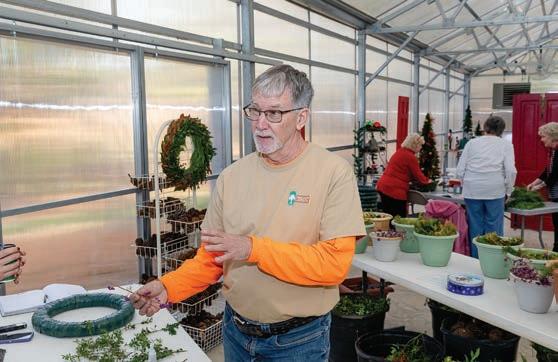
Down a winding gravel drive, just past the ducks and several greenhouses on the 400-acre Toms Creek Nursery property, a large, heated greenhouse awaits. Inside, straw wreath forms wrapped in dark green plastic sit two at a table with small tins of greening pins plus pairs of clippers. A few stations throughout the building are loaded with overflowing buckets of greenery and berries in scarlet and plum. And, of course, there’s hot cocoa, coffee and cookies. The only thing you need to bring to this hidden Denton treasure? Yourself and a little spark of holiday spirit.
“The first year, there were probably 10 people,” says horticulturist Jim Carraher, whose idea it was to start these wreath-making workshops, which began 20 years ago in unheated smaller greenhouses. “I’d been to a garden center that was up in Greensboro and they were selling greenery that you could take home and make into wreaths and, I thought, we’ve got hundreds of acres of plant material here.”
Now, in the greenhouse, over 40 people mill about planning their designs for their own wreaths. And that’s just one of many sessions available over a two-and-a-half-week period that begins the day after Thanksgiving. In 2023, the workshop broke 1,000 total attendees. Former nursery manager Brittany Andersen said at the time that their max capacity in a season is around 2,000, a number that depends not only on space but greenery available. The farm has trees that are specifically grown for this workshop. “But,” Andersen, had noted, “we need more trees to have enough greenery.”
This nearly century-old farm did not begin its life as a lush and idyllic setting that would draw mostly well-heeled urbanites for continuing education. But this nursery’s line of owners knows something about growth opportunities.
In 1934, single mother Ovie Henson purchased the property with her own money. Her husband, who’d been older than her and already passed his wealth on to his older children from previous marriages, died early in their marriage, leaving her with a son and not much else.
But Ovie was “tough people,” according to granddaugh-
ter Melinda Vaughan, the 70-year-old thirdgeneration proprietress of Toms Creek Nursery. How did Ovie, a single woman with a baby during The Great Depression, manage to purchase the farm she named after its creek? With money she earned from her job as a teacher in a one-room schoolhouse that she’d wisely invested in a little mill close to what would eventually become the N.C. Zoo. She traded off her stake in the mill for the first 200 acres.
“One of the old neighbors was a big farmer,” says Vaughan, “saying, ‘I am going to get that land for nothing because that little lady — she is going to go under.’”
Vaughan, whose blue eyes sparkle as she speaks of her Granny, holds herself proudly, her shining silver hair grazing her shoulders. “She proved him wrong though.”
With sheep and chickens, Toms Creek got its start, eventually adding cows. But it soon evolved when Ovie discovered she had a green thumb. Money that was earned from the plant portion of her business was fed right back into the community and given to the Quaker church she belonged to. While the dairy no longer runs, Vaughan recalls getting the cows in their loft before catching the bus for school as a youngster and remembers Granny milking them well into her 60s.
Today, Toms Creek Nursery is home to not only acres and acres of plants, but also its own landscaping and design company, run by Brandon Vaughan, one of Melinda’s sons. In addition to being owner, Vaughan is also the designer. In fact, Carraher, wreath workshop innovator, began on the landscaping crew. He met and married a woman from Denton and moved there with her after earning his B.S. in ornamental horticulture from N.C. State. And, as Vaughan plainly states about the Denton area, “There’s only one nursery big enough to hire a person.” So Carraher put down roots at Toms Creek. That was some 30 years ago.
These days, 67-year-old Carraher’s sole focus is the wreath
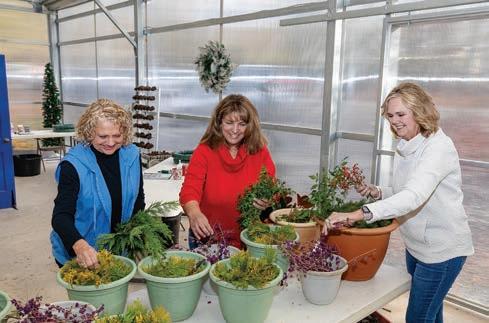

workshop. In 2021, in fact, the farm purchased a special T-shirt for his role. Pictured on the back of it? Why, a wreath, of course, the words “The Wreath Man” surround it.
Each workshop session runs two hours and change, during which time Carraher roams the greenhouse, answering questions and offering guidance as needed. Otherwise, it’s a free-for-all when it comes to the creation and design. The tools and materials are all provided. There’s an inspiration binder filled with images of wreaths Carraher and customers have created over the last 20 years. And sprinkled throughout the greenhouse, doors of all colors hold wreath hangers, welcoming customers to test their creations.
“Basically there’s no wrong or right way to do it,” says Carraher. “That’s the beauty of it all.” With several types of greenery and berries — Leyland cypress, American boxwood, D.D. Blanchard magnolia, blue Pfitzer juniper, American beautyberry, Norway spruce, Sunkist arborvitae, heavenly bamboo nandina berries, white pine, multiple yews and multiple holly berries — customers can create their own mix. And over two decades of workshops, Carraher has yet to see it all.
“When you mix up all these textures, even after all these years of doing it . . . some of them are just breathtaking,” he says.
For many, the Toms Creek Nursery wreath workshop has become a holiday tradition. Carraher recalls a group of young moms who hit the workshop as a break from their children. Two of those moms still carve out the time for it each year. “One of the two, she was pregnant the first time she came,” he recalls. “And now her son is 16 years old.”
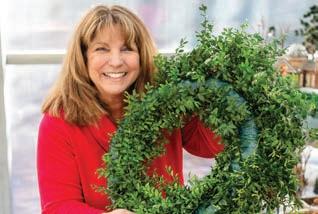
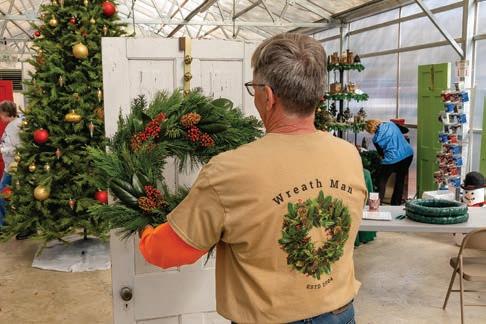


Sue Shumaker has been coming with her friend, Susan Short, and a varying group of women for about a decade. This time, she showed up with a dozen wreath-makers.
“I first came with Little Gate Garden Club in Asheboro and loved it so much, I invited Sue,” says Short. Since those first years at the workshop together, Short has moved to the Charlotte area. “I spent the night in a hotel last night so I could be here first thing this morning. That’s how much I love it!”
With so much experience under their belts, have their wreath-making skills improved over the years? Absolutely. But, according to Shumaker, there’s never been an ugly wreath that came out of this workshop. “Some are Southern Living-beautiful, but they’re all pretty. Every wreath that walks out the door is beautiful.”
The two friends recall a bittersweet memory during the COVID pandemic when a friend was ill and couldn’t attend. “Jim filled up a bag of goodies for me and I drove it to her house and put it on her porch,” says Shumaker. “That’s just like Sue,” adds Short, gazing at her friend.
Carraher also remembers the pandemic-influenced pivots: Tables were spaced out as they are now, but only one person to a table. During that time, he also offered pick-up of all the wreath-making essentials so customers could recreate the experience safely at home.
But today the workshop bustles with activity, the smell of Christmas pine wafting through the air.
“There is just something about a fresh wreath on the door,” says Vickie Whitaker, who’s attending for the second time.
“It really makes you think about Christmas when you were young. Years ago, we didn’t go out and buy







“ When you mix up all these textures, even after all these years of doing it . . . some of them are just breathtaking. ”
wreaths or buy decorations. We made them! I think that is part of it. Don’t you?”
“You’re still young!” her friend, first-timer Linda Powell, responds with a laugh. Powell entered the workshop doubting her creative skills. As the workshop progresses and her lush wreath nears completion, you’d never guess it was her first time.
And therein lies the magic. “It’s always that smile on that person’s face who was convinced they couldn’t do it — and they did,” says Carraher. “That’s what really sticks out the most.” OH
To book a seat at this year’s workshop, visit shop.tomscreeknursery. com.
By Billy ingram • PhotograPhs By Bert VanderVeen
ne hundred years ago this month, history buff
Mrs. Alice Bell founded the Greensboro Historical Museum, at first a purely aspirational effort seeking to canonize treasures of living memory related to the establishment and rapid growth of this then unassuming small town. That objective surely proved challenging for those who followed in Bell’s footsteps, when the 20th century unfolded and Greensboro became synonymous in the minds of too many Americans as being, all too often, most decidedly, on the wrong side of history.
Coinciding with the seventh anniversary of Armistice

Day, the Greensboro Historical Museum’s first public showing in 1925 consisted primarily of war era relics (Revolutionary, Spanish-American, Confederate and WWI), along with examples of evolving women’s fashions. Located in the downtown library’s basement, hundreds of historically significant curios salvaged from attics and closets around town neatly presented in five display cases “all that the museum association had funds for.” Admission for the couple of hundred people in attendance then, as it is now, was free.
In 1930, the museum, an all-volunteer, mostly female
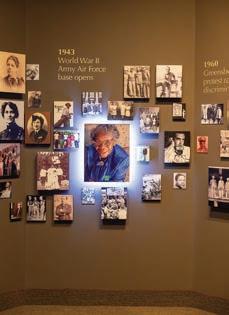
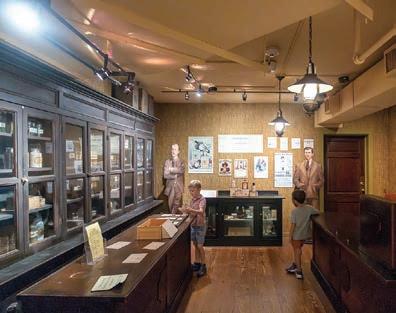


effort, took up residence in a former schoolhouse on Cypress Street until 1939, when the public library, with the museum and other civic organizations in tow, was installed in the original First Presbyterian Church building facing Summit Avenue. In 1964, the Greensboro Public Library relocated to North Greene Street, where Elon University School of Law is today, allowing the museum to expand into the entire 17,000-square-foot space, since expanded, it still occupies today.
Carol Ghiorsi Hart, director of the Greensboro History Museum for the last 12 years, and Curator of Community History Glenn Perkins walked me through the challenging yet inspiring task involved in weaving relevant and engrossing narratives around our city for limited-run events while simultaneously nurturing and preserving a sanctuary devoted to Greensboro’s
pivotal role in major historical events — the fight for our nation’s independence; the ending of the Civil War, sparking an Industrial Revolution in the South; sitting at the forefront of women’s suffrage; being a major military presence during World War II; and, its decades spent suspended on a razor’s edge during the struggle for civil rights and equality.
The staff must be in harmony with whomever it was that said “history gives answers only to those who know how to ask questions.” A fairly recent acquisition, but one of the oldest American artifacts the museum owns, is a knitted cap from the Revolutionary War. “We’ve done some DNA analysis on what may be a blood stain from that cap.” Awaiting the results, Perkins contends that just possessing a historical item is only the beginning of a journey of discovery, but “If you take good care of these things, they’ll continue to tell stories.”
Because of its affiliation with the Smithsonian Institute, not long ago, an original copy of the Emancipation Proclamation signed by Abraham Lincoln was on loan to our museum. Of course, anyone could find a scan of the document online or purchase a reproduction. “But,” Director Hart says, “the number of people who came to be in the presence of something Lincoln signed, who literally wept seeing it, was such a powerful moment.”
Museums in general are struggling, but the key to survival lies in adapting to an ever-shifting culture, with the focus no longer pointing inward. “Although we do have incredibly talented people, very knowledgeable,” Hart emphasizes, “there’s a recognition that, especially for a history museum, members of our community are authorities as well as we are — that we are all working together not only to document history, but to help shape what history looks like.”

That means taking what some might consider to be small family stories and placing them on equal footing with more wellknown names around town. “Greensboro’s history is one of arrival,” Hart says. “There’s a reason we’re called The Gate City and why, when people are drawn here for whatever reason, they bring change and vitality to the city.”
Inside the “This Just In” case greeting visitors on the second floor there’s a collection of hair crimpers, turners and curlers used by entrepreneur Pauline Farrar McCain, who attended Maco Beauty College in the late-1940s. “Maco was a Black-owned hair business,” an institution that trained over 1,000 beauticians between 1935 and 1969, Perkins explains, “established by folks who came to this city, the Londons, to make their own fortune.” After graduating, McCain went to work for Foust Beauty Shoppe
(“Where There’s Hair There’s Hope”) on East Market, subsequently purchasing it in 1960.
While hairstyles were being set back at her shop in the ’60s, McCain could often be found just blocks away participating in Civil Rights marches. For the last five decades, Foust Beauty Shoppe was located at 414 E. Market, where Mrs. McCain continued to oversee operations until her passing in 2020. “She was a community hub,” says Director Hart. “Often it’s not just about what we have on display, but how we can build on some of these stories and fill in some gaps.”
There was an exhibit 10 years ago on the Warnersville community that not only brought forth “a lot of oral histories, but also photographs and other things we hadn’t collected previously,” Perkins says. “We had another focusing on second generation

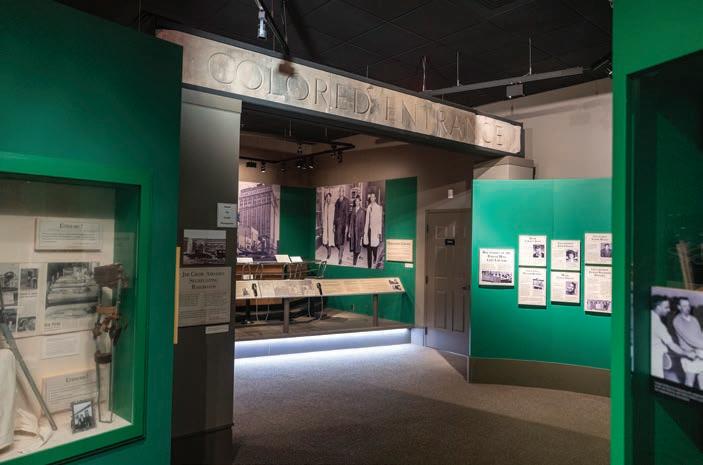
Asian Americans, another story that goes way back to the turn of last century, and the different businesses that were owned by Chinese immigrants.”
“Voices of a City” is the main attraction on the second floor, an Aladdin’s cave of life-sized, interactive dioramas arranged in a panoramic maze, each corner and corridor along this veritable time tunnel a snapshot of life from pioneer days forward. At the push of a button, excerpts from oral histories and historical testimonies augment the visuals, which are both exhaustive and stunning in their presentation.
For instance, one exhibit in this hall might seem incongruous, but is actually a clever juxtaposition. A familiar metal-and-neon sign that hung for decades in Blumenthal’s clothing store, enticing customers with a free pack of cigarettes if their receipt matched the numbers listed on the sign, that now hangs above an assortment of early contraptions used in denim manufacturing. Near the railroad tracks on South Elm, Blumenthal’s, from 1926 until 2005, was the young folks’ go-to retailer for Levis and Wranglers, while selling cigarettes manufactured locally at cost, even giving smokes away, to boost denim jeans sales.
There’s an alcove devoted to Army Air Force’s (AAF) Basic Training Center No. 10, later designated ORD (Overseas Replacement Depot). Surrounded by colorful propaganda posters enticing folks to “Buy Bonds” is one of the bunk beds tens of thousands of inductees slept in while being trained in ground and
air combat for some of the most decisive battles of World War II. The largest U.S. military base located inside the limits of a city was situated down and around East Bessemer Avenue from 1943 until 1946.
“Most people think a history museum is going to be filled with a lot of dusty old stuff and be sort of boring and be all about dates and places,” Hart points out. “So one of the things we’re trying to do is to shift that perception a little bit.”
Where else could one experience the momentary joy of reconnecting with ripples from a past thought to be lost forever? For me, it was seeing once again the Art Deco neon WBIG Radio sign that hung in its studio, beginning in the 1930s, recently restored at great effort — then, hearing the voice of WBIG’s legendary morning show DJ and family friend Bob Poole. A nod to our city’s rich broadcasting legacy, with tributes to George Perry and Sandra Hughes of WFMY-TV, WGHP sportscaster Charlie Harville, and WEAL’s Alfred G. Richard.
A bone of contention for museums lately has been an inadvertent stockpiling of culturally significant items appropriated by amateur archeologists or gathered up unthinkingly on foreign shores as souvenirs. “We sent back a number of things that were treasures of war during World War II that came into the museum.” Consisting of Japanese dog tags, good luck flags and other ephemera that American soldiers brought home with them, Perkins says they realized, “Those don’t belong here. Part of our work is returning things to appropriate places, and that can be part of the inhaleexhale of a museum.”
Making collections more readily accessible to the public is a primary goal moving forward, with transcripts of oral histories and some 15,000 photographs already easily searchable online through


UNCG’s Gateway project (gateway.uncg.edu/greensboromuseum).
Bernard Cone’s photo albums from 1900 through the 1910s; The Art Shop owner Charles Farrell’s photographs highlighting the city’s growth from the 1920s into the 1940s; Greensboro Fire Department scrapbooks; maps of Greensboro and Guilford County dating back to the 1870s; documents pertaining to local union organizing; the Abraham H. Peeler Papers, chronicling the evolution of African American education locally; letters, memorabilia and documents belonging to writer William Sydney Porter (O. Henry); these are just an inkling of the museum’s digital footprint.
Greensboro History Museum members receive a twice-a-month digital newsletter, a printed ROAR newsletter, early notice on happenings, plus invitations to members-only gatherings. There are also behind the scenes tours for contributors. “People love to go behind locked doors,” Director Hart says. “We have on the order of 30,000 objects, most are in storage but not in dusty boxes in the basement, they’re well cared for and numbered.”
During one of those “backstage” tours you can view rarities not currently on display or possibly never before seen by the public. Take, for instance, a pristine velvet, silk-lined cloak, embroidered with Indian or Iranian gold stitching from 1805 and gifted to future First Lady Dolley Madison by the first Muslim diplomatic
ambassador to visit the United States. This item of clothing is significant for a number of reasons, not the least being that, back in 1789, Morocco was the very first country to recognize the United States as an independent nation, before the Revolutionary War had been won.
Because I have great admiration for our world class GFD, a wooden bucket with a leather strap dated 1828 was brought down from storage for us to photograph, typical of those used by fire brigades long before Greensboro had any form of an organized fire department. Two hundred years ago, first responders (neighbors) would pass one bucketful of water at a time down a line of volunteers, from the well to the flames and back again to refill. Taking great pride in their efforts, those sturdy pails were decorated with the brigade’s logo and other flamerelated flourishes.
It’s true, we will never again walk casually through the unencumbered doorways of youth, bathed in the warmth of worlds that long ago ceased revolving. Tipping back into the deepest recesses of memory, connecting even momentarily to people and places associated with what the march of time has mercilessly (or mercifully) bulldozed in its path, is the continuing contribution our Greensboro History Museum offers all of our lives, year in and year out, hopefully for the next 200 years. OH

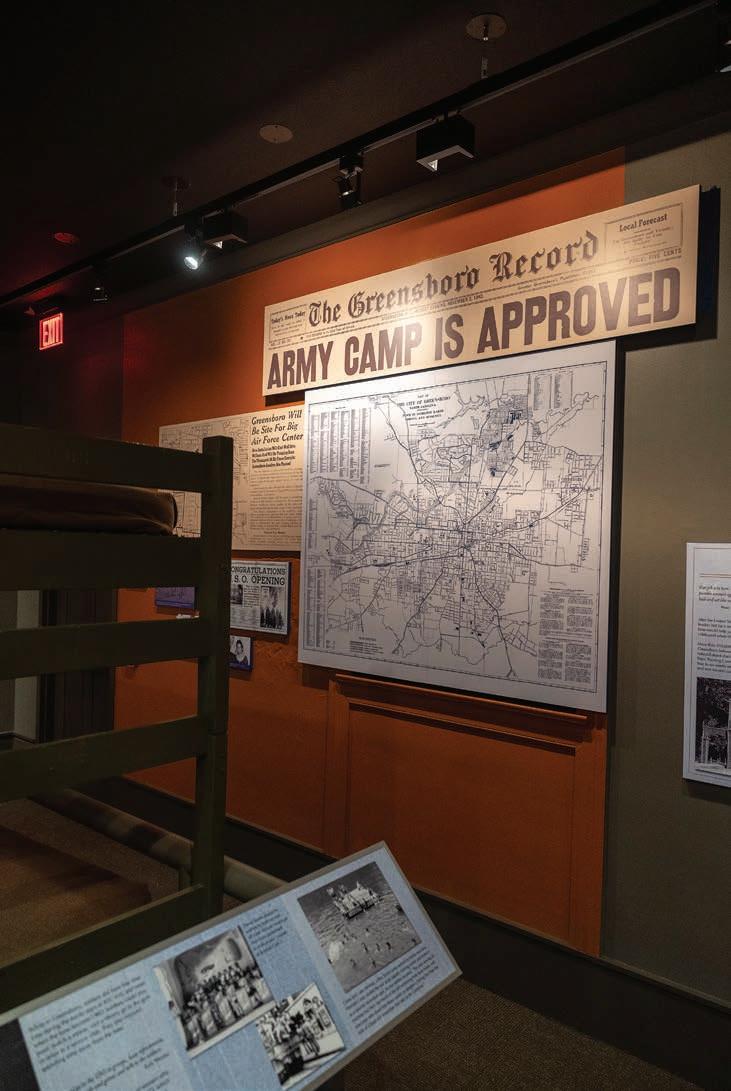



By Billy ingram • PhotograPhs By Bert VanderVeen
n one otherwise uneventful afternoon, two working moms unleash unleash their three adorable offspring — Owen (6) and Ellie Thompson (3), along with Wilder Bustamante (6) — on the Greensboro History Museum. We tend to think of museums as being focused on adult interests, so these mothers must wonder if anything they encounter will fully engage with a modern child’s iPad-oriented attention span. In a stuffy old museum?!?

Wilder and Owen are excited about what discoveries await them. “Some museums have dinosaur bones,” Wilder exclaims. Do the boys secretly hope that, somewhere up ahead, dinosaur skeletons will spring to life at any moment?
By design perhaps, a young mind will instantly recognize museums as safe spaces where imagination flourishes, fueled by their innate curiosity and sense of wonder. Plus, this place has multiple stages for play acting.


Wilder may be pointing out the many ways these kids are lucky to be living in modern times and not in the days before any form of entertainment they are familiar with was ever even imagined in the wildest science fiction stories.
“I’ll get it!!!” little miss Ellie shouts as the family telephone rings. It’s Ellie’s new beau calling, asking her out to the Carolina Theatre to see Clara Bow’s latest moving picture. Ellie exclaims, “That’s the cat’s meow!”
Following the picture show, they’ll stroll a few blocks to lean dreamingly over the soda fountain at Fordham’s Drug Store downtown, sharing a lavender malted milkshake — two straws, of course. They grow up so quickly, don’t they?

Tumbling into another room, our three adventurers happen upon an early mobile fire-fighting vehicle used by our own fire department. Owen informs everyone, “Those fire engines are so old, they must be from the 1980s.” Owen’s mom is actually from the 1980s and lets out a laugh!
At the dawning of the 20th century, this Greensboro fire truck, the General Greene, was yanked into action by a horse named Prince, the most photographed and talked about equine of that time.
Why was that? Because, after dousing the flames, firefighters would get the horse drunk on the most expensive whiskey available. But there’s no reason for these young’uns to know anything about that!
For a passing moment, a midcentury living room captures their attention, back when the TV set was furniture you couldn’t sit too close to. Why did everything from lounge chairs to refrigerators come in shades of lime green? To this day, no one knows.
Like squaresville, man.

A lone child standing alongside an actual covered wagon from the 1750s accentuates the enormous undertaking pioneer families were faced with, all of their belongings bundled inside, making their way South down the Great Wagon Road in search of a better life.
This road wagon was first class travel for those traversing an untamed wilderness before the advent of railroads.
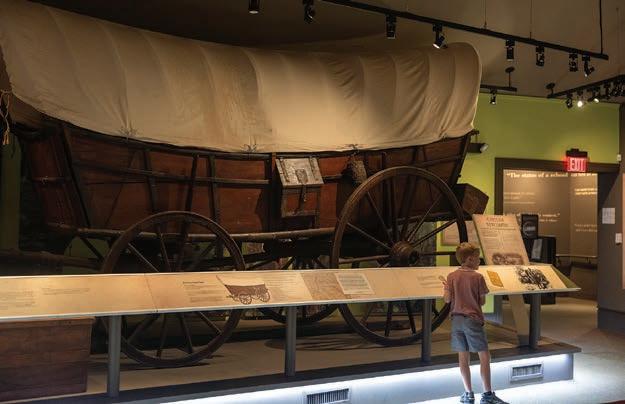

Owen positions himself in front of a keyboard, ready to type out tall tales of knights in shining armor slaying fire-breathing dragons, damsels in distress being rescued from watery ponds, or, perhaps, the thrill of hitting a World Series-winning home run? The possibilities are endless, but, while the letters and numbers on the keys all look familiar, the battery appears to be dead . . . and where did they hide the “send” button?

Li’l sluggers Owen and Wilder enjoy attending games at the nearby baseball stadium, so they’re staring in awe at uniforms and equipment used by both the Greensboro Bats and Grasshoppers. “It looks like toys,” Wilder says about the display they both agree is their favorite in all of the museum.
A simple encapsulation, yet they returned repeatedly because it’s history that relates to their life experience.

Kiddos are naturally inquisitive and curious. These boys are just now learning to read, but that’s no hurdle with information at their fingertips. But how would modern kids know which end of the receiver to put to their ears? It’s evolutionary, my dear Watson!


Not all superheroes wear capes. Back in 1957, Josephine Boyd was hassled and bullied constantly in high school, but served as an inspiration to millions of young people by bravely being the first to attend a school where she was unwelcome simply because she was Black. She graduated with honors.
Today, the road in front of that high school is named Josephine Boyd Street.
Wilder and Owen went running back into the Voices of a City exhibit to experience what went unnoticed the first time through. They are found, fascinated by broadcast technology from more than 50 years ago, watching George (Old Rebel) Perry, who entertained local kiddies for 25 years on WFMY.
In the ‘60s and ’70s, George Perry would carpool kids from the Hayes-Taylor YMCA to appear in the audience so that viewers at home would see how diverse our community was . . . and still is.

Wilder instinctively runs toward the Woolworth’s sit-in exhibit. Is it a fascination with the shiny chromed seats and lunch counter accents or the voices of societal change he’s tuned into?
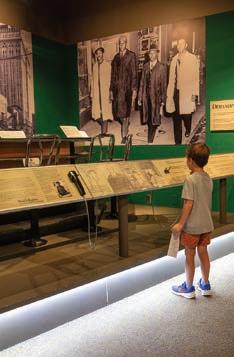

“Time to go!” Mrs. Thompson calls out. But where are those boys?
All good things must end but these indefatigable imps demand a return visit, despite encountering exactly zero dinosaurs stomping around the grounds.
On the way out, our two moms drop a few dollars into the donation box. “Anything keeping our Energizer bunnies entertained for an hour or two gets a big tip from us!”
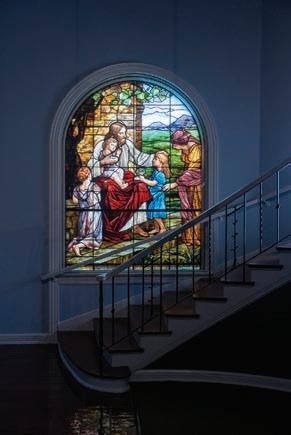
This was an actual, spontaneous visit to the Greensboro History Museum by two busy mothers with their three young children. Nothing posed, planned or coerced, we merely tagged along like Allen Funt.


Elizabeth Wicker was always adventurous — enjoying travel, studying abroad and seeking new experiences. But a transformative trip to India provided a kaleidoscopic view of richer creativity for the Chelsea House designer.
Elizabeth Wicker’s home renovation is a living laboratory, where she tinkers with sophisticated, restrained design, luxe wallpapers and sparkling touches. And yet there is a disciplined approach, and no clutter.
In her dining room/home office, she recently created a credenza in her role as a Chelsea House designer. The piece, newly arrived, could be popped between the two new bookcases of her design, or be used elsewhere, she says. A small, blown-glass bull on the shelf was purchased at Modern 214 in High Point, however, redolent of her time in Spain, and is not her design. She holds it in her hand, thoughtfully weighing it.
An ethereal Douglas Freeman painting hangs between the two bookcases.
The dining table, doing double duty as her work table, is a glamorous Hollywood Regency style also found at Modern 214. “It’s the first place I go when I get to market.”
The wall color used throughout much of the upstairs is a pale Benjamin Moore gray, number 1611, a favorite, trimmed with Decorator’s White in high gloss — a serene backdrop to art and furnishings. If it reads too blue with different light, she tweaks the tint.
“This is my house. My passion project.”
The graphic wallpapers Wicker chose 10 years ago when she first moved in still work.
Cranes wallpaper by Cole & Son in the foyer is a favorite. Her older brother walked in as the house was being renovated and stopped. “Beeb” (her nickname), she recalls him saying, “this wallpaper reminds me of something from our house growing up.” She laughs and shrugs. (But privately, she’d wondered, had something in her past inspired the choice?)
Wicker’s home, however beautiful, is equally spotless.
She enthusiastically describes snuggling on the neutral living room sofa with her poodle-Cavalier King Charles mix, Sienna Rose. (The settees and sofas are all custom-sized to fit each niche and space, a benefit of working in the industry.) “Only if she has her blanket,” Wicker qualifies.
She sheepishly continues.
“I’m a little OCD about cleanliness.” Her friends tease her with

a barrage of questions: “Do I have shoes for her to wear if it gets really muddy?” Yes. “Do I make her wear them all the time?” No. “But did I try when she was a puppy?” Yes.
“Sienna Rose has been the best thing for me.”
Wicker moves through her home, picking up objects to illustrate her design style. A line of mother-of-pearl boxes are personal favorites. Sales reps told her they were a little pricey, but she stood her ground.
“Well,” she told them, “Let’s see if you can do it!” The boxes wound up being a best seller, she says proudly. But that is not always the case. Home furnishings sales are mercurial, with vari-

ables such as bad weather, poor market attendance or poor buyer traffic at any given market. A white cachepot of her design has remained a best seller for Chelsea House. She has another one out, and two new trays are styled on kitchen counters, one using mother-of-pearl.
Among the 100 or so pieces she designs each year are personal favorites that don’t make it into production. If this disappoints her, Wicker doesn’t complain. Rarely, too, is she disappointed by a design’s execution in manufacturing.
Wicker pauses before a large Art Deco-style mirror template she taped to the wall behind her desk. She studies the physical

pattern a moment while scrutinizing the computerized version on one of two work screens. Details consume her and must be exact.
“This is the reason I bought the house,” she says, leading downstairs, shot with abundant natural light and luxuriant space.
The basement level is a revelation. Equally restrained, it is also light, youthful and fun, designed for comfort and also further design experimentation. Wicker camouflaged an unfortunately placed fireplace with antique mirrors and reconfigured the large space, where she formerly worked.
She points out Chelsea House designs used in the decor here.
“Down here is a bestselling cocktail table, lacquered, originally
detailed in gold leaf.” Wicker personally favors small cocktail tables with heft, which she says are useful when entertaining, substantial enough to not tip over.
A side table in crisp white with brass accent is a signature Wicker design.
The glamorous basement powder room featuring a graphic wallpaper and a “Material Girl”-era Madonna photograph is much appreciated by her close friend, lawyer Andrew Spainhour. He teases Wicker, saying, “Pardon me, I’m going to go visit Madonna.”
He has dubbed Wicker’s downstairs her “Genie room.”

“Like I dream of I Dream of Jennie, where she went to the bottom of her genie bottle?” Wicker explains. She’s piled cushy pillows around the sectional sofa.
A framed collection of vintage Vogue illustrations is a nod to Wicker’s fashion background.
The basement opens onto a covered outdoor entertaining area with a louvered privacy wall of her design that includes a hidden jib door. There’s ample space for Sienna Rose to run, she adds, nodding towards the large yard. Here, too, Wicker’s neatnik nature is on full display. Dog toys are neatly stacked as her pooch visits Wicker’s parents.
“I sit at the end of that step,” she shares, clearly besotted by her
pet. “Sienna Rose gets to the fourth step and tends to look back to be sure I’m still there.”
Upstairs, she describes having revamped bathrooms, then transforming spaces by hanging papers selectively for graphic punch. By claiming much of the primary bedroom’s closet, Wicker expanded a formerly cramped en suite bath.
Striking details, like the impressive brass pulls on custom bathroom cabinetry, reveal a little more genie-style magic.
“They’re actually tie-backs,” Wicker says.
An antique French settee in her bedroom fits her maxim: You “must mix the old with the new.” Wicker lacquered a vintage credenza to make it read more of the moment.


The artwork she acquired fits with elegant restraint. Nothing competes with anything else. She mentions two favorites — eyecatching, large canvases. One hangs directly in front of her work table.
Both are by Freeman, an admired artist and her friend.
“When he brought this over, he said he wanted this in the hallway.” Wicker was hesitant as workmen were still on site; she didn’t want it harmed. Freeman was insistent, hanging it where it remains today. It is all the more meaningful to her as he subsequently died.
She smiles wistfully; it is a grace note.
“It’s my little labor of love, and I love my home,” she repeats, then flashes an enormous smile.
When Elizabeth Wicker was profiled as a Triad boomeranger — those ultimately returning home — it still surprised even her. She never expected a return to Greensboro after a career-making move to the Big Apple, where she worked for fashion maven Nanette Lepore.
Today, she sees a beautiful symmetry to her trajectory and believes here is exactly where she is meant to be.
“I’m a boomerang and I’m all down for it,” Wicker says.
“Cecelia Thomspon [executive director of Action Greensboro] is
one of my best friends here.” Thompson conceived the very idea of Boomerang Greensboro, which promotes those who formerly lived here returning.
Initially, a series of unfortunate events brought Wicker back in 2014.
A creative pivot from fashion to furnishings design was unexpectedly easy for Wicker.
Years perfecting dressmaker finishes and finer details for haute couture lent itself to the granular detail she now applies when designing for home furnishings giant Chelsea House. At 44, she is enjoying a challenging career working with home appointments versus high fashion.
Wicker is among 10 designers working independently for Chelsea House, which celebrates its 50th anniversary this year.
How her reset unfolded is one part fairy tale and ten parts hard work. Her design evolution also involved a revelatory business trip to India. When Wicker returned to Greensboro, those parts meshed in a transformative way.
She was always an independent, free spirit, remembers friend Sara Jane Gibson, who has known Wicker “since we were in diapers in the same play group. I tuned into this in high school.” She noticed her friend’s unique dress style and eye for design. Wicker’s bedroom was pasted with a collage of varied photographs from ceiling to floor—anything that she fancied. “She had stickers on the interior roof of her car.”
It presaged her home, which became a personal design laboratory.
In her early years, Wicker was influenced by family travels. She

observed how her grandmother “sewed everything,” and soon grew passionate about sewing and creating, even as a teenager.
Wicker pursued fashion design at N.C. State after graduating from Page High School and studied abroad in Spain. Still in college, she produced handbags and clutches under her own brand, Isabaya by Elizabeth Wicker. “I didn’t keep up with the trademark,” she says.
When the televised design competition Project Runway began its popular run, watching the pace stressed her out, she recalls. Then a student, she couldn’t believe the show’s contestants made designs so quickly.
Despite all that, Wicker confesses imagining she’d eventually study law and follow her father, Robert Wicker, in becoming an attorney.
Yet design opportunity opened. She won an internship with Lepore in New York, where she remained for six years. This led to Lepore employing Wicker as a liaison between design and production.
“Lepore was known for her details, embellishments,” Wicker says with admiration. “Intricate designs. Nothing was just basic.” The free-spirited designer matched Wicker’s own enthusiasms — “a little gypsy” spirit. “I loved working with her; it was so much fun, and living in New York was fantastic.”
But a series of setbacks for the design house hit. (The designer no longer owns the brand and has since shuttered her studio.) Then Wicker’s rent escalation forced her to give up her apartment in March 2008.
Yet she hadn’t contemplated returning to her hometown. “I’d had all these great experiences — it felt; ah, am I ready for that?” Then her parents ran into her former soccer coach, who works in the textiles industry. He relayed a message to Wicker: “Tell her to send me her resume.”
She relocated to Greensboro and joined underwear-and-hosiery manufacturer Kayser-Roth. After a year, she met and joined Triad designer Bradshaw Orrell, partner of the late Freeman, and began working with his clients and, ultimately, managing the business.
Orrell was already designing for Chelsea House. In the process of the firm working on their High Point showroom, Wicker had begun ghost-designing for Chelsea House, too, “which isn’t odd at all in the design world.”
Then, a misadventure changed her career once again.
Orrell asked Wicker to join him on a business junket visiting 26 India manufacturers for Chelsea House. She only knew they would be “seeing their capabilities and seeing products that were already in the works that we had designed.”
Arriving in New Delhi in January of 2020, Wicker quickly cleared customs. Orrell did not. She watched helplessly through a glass panel with mounting alarm as he was turned back by customs officials.
“They sent him back that night because his visa was not up to date . . . and I’m just his sidekick going on this trip!” Although she was familiar with the process of how furniture pieces are made, “I had never been in India, and didn’t know exactly what Chelsea House wanted and what we were to do.”
Wicker didn’t even know any contact names of those they were meeting.
Their prearranged agent, Parik, met her at the airport with knowledge of the itinerary. She realized she had to go to four appointments the next day, unsure of what was expected, nor how to navigate expectations.
Gibson, who lives in Charlotte, called Wicker five times when she learned her friend was there alone.


“I just knew she was going with her boss . . . she’s savvy and could have navigated, but I was just worried about her.” Gibson adds, “She’s always had a big personality . . . She’s a leader and a woman on a mission.”
“It was mind blowing. Amazing. But I got so sick,” Wicker recalls. She had packed basics for stomach upsets and headaches that did little for her symptoms. Her whole body ached.
“My throat closed up. It wasn’t until about six months later that I realized it was COVID.”
Wicker isn’t an adventurous eater at best, and now she had no sense of taste nor smell. Parik diplomatically told everyone she only “ate dry food.” She munched on crackers and granola bars. And kept going. Wicker never smelled the rich curries and spices that are the stars of Indian cuisine.
After that first day in India, she thought, “I can do this!” She had moved from “I have to do this” to “I can do it!” At night, she would collapse in bed, sweating and ill. She lost her voice and could barely communicate. But she soldiered on.
Factory managers would ask Wicker whether she liked things they presented, carefully waiting for her to speak. “I wasn’t sup-
posed to be the main person, but they wanted to show me what they could do. Everyone was so respectful.” She could absorb the sensory richness — textiles and architecture — of India if not the foods and aromas. “The colors! I loved it all!”
With Parik’s help, Wicker completed the entire 12-day agenda on her own.
“I loved it,” she repeats. And her creativity ignited.
She had feverishly “designed about 75 pieces while in India in collaboration with the people at the factories.”
She flew back on a Sunday, her health improving. By Tuesday morning she was back at work, sending out new designs.
Wicker was exhausted. Elated. And changed.
She also turned 40 that summer, celebrating with a group of friends who have long been in her life. Wicker walks over to a bookshelf and picks up a magnifying glass she designed for friends as a party favor. It echoed her love of some of the nostalgic family items she values.
After returning from India, Chelsea House’s executives called Wicker to express support. By November, their new president contacted her about creating another line of furniture — in two

weeks. She managed while still working full-time with Orrell. She continued both until 2022.
“I learned so much there,” she says of her 12 instructive years with Orrell.
But India had changed “my thinking and career . . . It was the turning point.”
Her designs are also plucked from personal references and life experiences. An alabaster apple she designed from one of the reeded-front bookshelves literally reflects her time in New York, the real Big Apple.
This includes both furniture and “the jewelry” — her term for the accessories she designs, such as trays and cachepots.
“I put pressure on myself to give as many details as possible.”
What is the narrative thread in Elizabeth Wicker’s design life?
“Outside influences,” she answers. She went out into the world, like a design explorer, and brought it all back to her studio. New York City, Spain and then India became touchstone places.
Her Instagram page describes her as “chasing everything creative.”
“It’s a matter of letting yourself go. You may not be great at
something — but you find your way. Your mind, your heart, everything will tell you where to go. It will lead you, for sure. That happened to me.”
Random, even mundane things, can mean an epiphany.
“I found packaging — this piece of cardboard! The way it was cut out and folded, I opened it and thought, hmmm. This would be a great body of the lamp. A base!”
Or, while eating out West on vacation: “There was the coolest design on the end of the fork. Something I’d never seen before.” Her fellow diners were amazed she noticed.
“It’s definitely not one-two-three” she says. The design process is different every time. But she firmly believes in routines.
Up at 7, she religiously makes her bed and jumps in the shower. “I do things for myself. Alone time. Get up and moving, and Sienna Rose sometimes goes to doggie daycare or stays here with me.” Wicker is, failing calamity, working by 9:30.
“You’ve got to get in a routine, and I learned that long before COVID.”
There are long hours, too, she admits, “when you ask ‘What did I even get done?’”
Two weeks earlier, Wicker was on a getaway with girlfriends in Darien, Connecticut. While browsing the shops, she spotted one of her designs and had a moment. “This has never happened to me,” she insists. “The girls started saying, in high-pitched voices, ‘Oh my gosh!’”
The store owner asked Wicker’s name. “I turned beet red.” They requested a photograph of her with the piece. “It was a really cool experience. Then I looked over and spotted another of my pieces.” Her heart lifted.
What feeds her? Her parents were “guiding light people,” she praises. They gave her tools of self-reliance.
“They gave me the freedom to explore my creative side and to travel. No limitations set on me in the sense, I never remember their saying stop doing that.”
So she hasn’t.
Rituals for enhancing creativity? Noticing things. It may not inspire a new product idea. But perhaps the texture of a leaf, or the undulation of packing material, the mundane, pricks the subconscious inspiring a new finish.
Sometimes just walking along a path does the trick.
“Get a dog,” she winks. OH

Whodunnit again? Bestselling fiction trio Beatriz Williams, Lauren Willig and Karen White, known for their 2022 New York Times-bestselling novel, The Lost Summers of Newport, are back to thrill readers with another page-turning mystery. Step inside the walls of the historic Castle Kinloch, where a literary superstar has been found dead. Agatha Christie meets Knives Out in their forthcoming novel, The Author’s Guide to Murder.
Join us to hear our three writers discuss their new novel. Tickets include heavy hors d’oeuvres and two drinks (catered by Grandover).
Sunday, November 10, 2024
2 — 4 p.m.
Grandover Resort & Spa, 1000 Club Road, Greensboro, NC 27407
Tickets: ticketmetriad.com Supported by:





By Jim DoDson
G“Let us give thanks for this beautiful day. Let us give thanks for this life. Let us give thanks for the water without which life would not be possible. Let us give thanks for Grandmother Earth, who protects and nourishes us.”

enerations of Americans who were schoolchildren during the Ozzie and Harriet years from the 1950s through 1960s have keen memories of singing an ancient hymn long associated with Thanksgiving titled “We Gather Together.” In fact, the hymn had nothing to do with the mythologized first Thanksgiving held by the Pilgrims in November 1621. Based on a Dutch folk tune, the hymn was written in 1597 to celebrate the Dutch victory over the Spanish forces at the Battle of Turnhout. Prior to that, Dutch protestants were forbidden to gather for religious observances. It first appeared in American hymnals around 1903 and rapidly gained popularity as the Thanksgiving hymn sung at church services and in public schools during the week of the November holiday. In 1992, comedian Adam Sandler performed his own mocking version of the holiday standard on Saturday Night Live that more or less coincided with “We Gather Together” being removed forever from public schools and gatherings. The hymn is still a staple in churches across America at Thanksgiving.
The holiday itself has something of a checkered and violent history. The highly mythologized account of the first Thanksgiving “harvest feast” shared by English Pilgrims and the Wampanoag people in 1621 generally ignores the fact that disease brought by the colonists to North America wiped out 90 percent of New England’s native populations. Following a major Patriot victory in the Revolutionary War, George Washington proclaimed the first nationwide Thanksgiving celebration in America, marking Nov. 26, 1789, “as a day of public thanksgiving and prayer.” He was then upstaged by Abraham Lincoln 74 years later, who formally established the national holiday when he issued a proclamation for a National Day of Thanksgiving in October 1863, following the Battle of Gettysburg, in which 50,000 soldiers died. In 1939, Franklin Roosevelt moved the Thanksgiving holiday one week earlier than normal to the second-to-last Thursday in November, believing that doing so would help bolster retail sales during the final years of the Great Depression.


Regardless of these inconvenient truths — and Adam Sandler’s buffoonery — the overwhelming majority of us in a wonderfully diverse America embrace Thanksgiving as a welcome opportunity to gather with family and friends and celebrate however we see fit with food, football and a nice afternoon nap.

— Traditional daily prayer of the American Lakota people
By Edna St. Vincent Millay
I cannot but remember
When the year grows old — October — November —
How she disliked the cold!
She used to watch the swallows
Go down across the sky,
And turn from the window
With a little sharp sigh.
And often when the brown leaves Were brittle on the ground,
And the wind in the chimney
Made a melancholy sound,
She had a look about her
That I wish I could forget —
The look of a scared thing
Sitting in a net!
Oh, beautiful at nightfall
The soft spitting snow!
And beautiful the bare boughs
Rubbing to and fro!
But the roaring of the fire, And the warmth of fur, And the boiling of the kettle Were beautiful to her!
I cannot but remember
When the year grows old — October — November —
How she disliked the cold!



Before attending any event, it’s best to check times, costs, status and location. Although we conscientiously use the most accurate and upto-date information, the world is subject to change and errors occur!
November 1–31
INTERPRETING AMERICA. A collection of photos from the archives provides commentary on life in America from the late 19th century up to the present. Free. Weatherspoon Art Museum, 500 Tate St., Greensboro. Info: weatherspoonart.org/exhibitions/current-exhibitions.
MAKING CONNECTIONS. This installation of works from the Weatherspoon’s own collection showcases the gallery as an academic museum with deep connections to its campus, Greensboro and broader communities. Free. Weatherspoon Art Museum, 500 Tate St., Greensboro. Info: weatherspoonart.org/ exhibitions/current-exhibitions.
CRIP*. This group exhibition features contemporary artists who explore disabilities and the ways their personal experience of disability intersects with other aspects of their lives. Free. Weatherspoon Art Museum, 500 Tate St., Greensboro. Info: weatherspoonart.org/ exhibitions/current-exhibitions.
November 1–3
CARRIE: THE MUSICAL. Times vary. Stephen King’s thriller about a teenage girl’s supernatural vengeance takes the stage, complete with song. Tickets: $30. Sprinkle Theatre, 402 Tate St., Greensboro. Info: vpa.uncg.edu/events.
BLACK SOUTHERN WRITERS
CONFERENCE. The Griot & Grey Owl Black Southern Writers Conference offers three days of transformative events that unpack the theme of “Home & Heritage” with multi-sensory experiences curated by culture-shifting writers. Tickets: $75+; Friday’s events, free. 120 Morris St., Durham. Info:griotandgreyowl.org.
November 1–2
THE ART OF INCLUSION. “Indelible” presents four artists who create works that embrace melancholy while offering the possibility of transcendence. Free. GreenHill Center for NC Art, 200 N. Davie St., Greensboro. Info: greenhillnc. org/exhibitions.
November 1
FIRST FRIDAY. 6–9 p.m. Head downtown for a night of live music and happenings stretching all the way from LeBauer Park and the Greensboro Cultural Center to the South End. Free. Downtown Greensboro. Info: downtowngreensboro.org/first-friday.
GOLD OVER AMERICA. 7 p.m. Athleta presents some of America’s best gymnasts, including

November 2 • High Point Museum
the most decorated of all time, Simone Biles. Tickets: $33+. Greensboro Coliseum, 1921 W. Gate City Blvd., Greensboro. Info: greensborocoliseum.com/events
DAVID SEDARIS. 8 p.m. Known for his sardonic wit, the New York Times-bestselling humorist takes the stage for a night of quirky storytelling. Tickets: $50+. Steven Tanger Center, 300 N. Elm St., Greensboro. Info: tangercenter. com/events.
ZOSO. 8 p.m. If you’ve got a “Whole Lotta Love” for Led Zeppelin, don’t miss the ultimate tribute experience. Tickets: $25+, Carolina Theatre, 310 S. Greene St., Greensboro. Info: carolinatheatre.com/events.
November 2–30
LIFE & ART OF CHARLES M. SCHULZ. Curated by the Charles M. Schulz Museum in California, this exhibit details the artist’s life, including a replica of his drafting studio, and introduces the viewer to each of the Peanuts characters. Tickets: $4 in advance, $6 at door. Alamance Arts, 213 S. Main St., Graham. Info: alamancearts.org.
November 2
CHORAL SOCIETY OF GREENSBORO. 7:30–9 p.m. Creative Greensboro kicks off its City Ensemble Concert season with a choral performance. Free, donations appreciated. Virginia Somerville Sutton Theatre at Well-Spring,4100 Well Spring Drive, Greensboro. Info: greensboro-nc.gov (click on “events”).
CHRIS THILE. 7:30 p.m. The genre-blending mandolin virtuoso is joined by violinist Marjorie Bagley. Tickets: $35+. Steven Tanger Center, 300 N. Elm St., Greensboro. Info: tangercenter. com/events.
PIGSTOCK. Noon–5 p.m. Pig out at a family-friendly BBQ competition and bluegrass music event benefiting Children of Vietnam, a nonprofit that provides education, nutritional support and other resources to impoverished children in Vietnam. Tickets: $40+. Shooting Star Horse Farm, 5624 Davis Mill Road, Greensboro. Info: pigstockbbq.com.
WILL DOWNING. 7:30 p.m. “The Prince of Sophisticated Soul” performs an evening of R&B classics. Tickets: $41.36+. High Point Theatre, 220 E. Commerce Ave., High Point. Info: highpointtheatre.com/events.
DÍA DE LOS MUERTOS. 10 a.m.–2 p.m. Enjoy family entertainment and crafts while learning about the holiday celebrated in honor of the loved ones no longer with us. Free. High Point Museum, 1859 E. Lexington Ave., High Point. Info: highpointmuseum.org.
COUPLES THERAPY. 8 p.m. Enjoy a night of hilarity as you dive into an interactive theatrical show about couples therapy. Tickets: $20+, Carolina Theatre, 310 S. Greene St., Greensboro. Info: carolinatheatre.com/events.
ANDREW RUDICK. 8 p.m. He’s one of the fastest rising comics in the Midwest and he’s taking his schtick to a stage near you. Tickets: $15. The Idiot Box, 503 N. Greene St., Greensboro. Info: idiotboxers.com.
November 3 & 17
BLUEGRASS & BRUNCH. 11 a.m.–1 p.m. Enjoy live bluegrass and folk music while munching tasty treats from vendors. Free. LeBauer Park, 200 N. Davie St., Greensboro. Info: greensborodowntownparks.org/calendar.
November 3
MADE 4 THE HOLIDAYS. 11 a.m.–4 p.m.
Shop a juried show of area makers and artisans selling handmade wares such as jewelry and pottery. Greensboro Farmers Curb Market, 501 Yanceyville St., Greensboro. Info: facebook. com/events/1930134984172296.
PUPPY PALS. 7 p.m. It’s a night of stunts and treats as man’s best friends, as seen on America’s Got Talent, tackle tricks with comedic flair. Tickets: $20; children 12 and under, $15. Carolina Theatre, 310 S. Greene St., Greensboro. Info: carolinatheatre.com/events.
November 4
SMOKE SIGNALS. 7 p.m. In celebration of Native American Heritage Month, watch this coming-of-age film, recognized as the first to be written, directed and produced by Native Americans. Tickets: $8, Carolina Theatre, 310 S. Greene St., Greensboro. Info: carolinatheatre. com/events.
November 6, 13, 20
FAMILY NIGHT. 5–7 p.m. Enjoy an art-driven evening with family and friends in the studios. Free. ArtQuest at GreenHill Center for NC Art, 200 N. Davie St., Greensboro. Info: greenhillnc. org/events.
MUSIC IN THE PARK. 6–8 p.m. Sip and snack at LeBauer Park while grooving to local and regional artists. Free. Lawn Service, 208 N. Davie St., Greensboro. Info: greensborodowntownparks.org/calendar.
November 6
READING THE WORLD. 7–8 p.m. Discover contemporary authors’ works in translation, such as this month’s selection — a harrowing novel depicting the travails of West African immigrants in France — Three Strong Women by Marie NDiaye Free. Online. Info: scuppernongbooks.com/events/calendar.
November 7
UNCG JAZZ II. 7:30 p.m. The ensemble celebrates the music of trumpeter Kenny Dorham. Tickets: $9+, The Crown at the Carolina Theatre, 310 S. Greene St., Greensboro. Info: carolinatheatre.com/events.
November 8
SESAME STREET. 6 p.m. All of your favorite neighborhood muppets — Elmo, Cookie Monster, Abby Cadabby and friends — appear live on stage for an evening of sunny days, sweeping the clouds away. Tickets: $27.50+. Steven Tanger Center, 300 N. Elm St., Greensboro. Info: tangercenter.com/events.
WILLIAM LEE MARTIN. 7:30 p.m. Affectionately known as “Cowboy Bill,” this Texas comedian delivers a night of heartwarming laughter. Tickets: $30.69+. High Point Theatre, 220 E. Commerce Ave., High Point. Info: highpointtheatre.com/events.
KRUGER BROTHERS. 8 p.m. Melodies

meet stories when this band performs its unique blend of bluegrass, folk and classical with Kontras Quartet. Tickets: $30+, Carolina Theatre, 310 S. Greene St., Greensboro. Info: carolinatheatre.com/events.
November 9, 16, 23, 29, 30
GREENSBORO LAUGHS. Times vary Live, laugh and laugh some more at this standup comedy showcase. Tickets: $6+. The Idiot Box, 503 N. Greene St., Greensboro. Info: idiotboxers.com.
November 9 & 16
CRAFTY KIDS CLUB. 11 a.m.–1 p.m. Trained research assistants from UNCG’s DUCK Lab guide children ages 3–12 through creative endeavors that foster age-appropriate skills. Free. LeBauer Park, 208 N. Davie St., Greensboro. Info: greensborodowntownparks.org/calendar.
November 9
GREENSBORO HONORS. Noon–3 p.m. The annual Veterans Day parade rolls through downtown Greensboro, honoring those who have served in the U.S. military. Free. Intersection of Lindsay and Elm Streets, Greensboro. Info: gcdav20.com.
JAZZ WORKSHOP. 3–4:30 p.m. All levels of musicians are welcome to listen, jam and discuss the feel of jazz. Free. The Music Academy of North Carolina, 1327 Beaman Place, Greensboro. Info: musicacademync.org.
JAZZ NIGHT. 7–10 p.m. Sip vintage craft cocktails and snack on tapas while a jazz entertainer performs for the evening. Free. O.Henry Hotel Social Lobby, 624 Green Valley Road, Greensboro. Info: ohenryhotel.com/o-henry-jazz. BLACK VIOLIN. 8 p.m. Hard-hitting beats merge with whimsical string melodies in Black Violin’s 20th anniversary tour. Tickets: $26.50+. Steven Tanger Center, 300 N. Elm St., Greensboro. Info: tangercenter.com/events.
CHRISTIAN NODAL. 8 p.m. The winner of six Latin Grammys performs a night of Mexican hits. Tickets: $41+. Greensboro Coliseum, 1921 W. Gate City Blvd., Greensboro. Info: greensborocoliseum.com/events.
RIC ROBERTSON BAND. 8:30 p.m. The Americana-style singer-songwriter celebrates his newest album, Carolina Child. Tickets: $20+. Flat Iron, 221 Summit Ave., Greensboro. Info: flatirongso.com/events.
LIMITED ENGAGEMENT BAND. 7:30–10:30 p.m. This incredible cover band takes you on a musical journey through the ages. Free. Grapes and Grains Tavern, 2001 Yanceyville St., Greensboro. Info: grapesandgrainstavern.com.
November 10
BIG BAND. 3–5 p.m. Swing dancing — or sitting back and relaxing — is encouraged as the Greensboro Big Band performs. Free, donations appreciated. Van Dyke Performing Space, 200 N. Davie St., Greensboro. Info: greensboro-nc. gov (click on “events”).
U.S. AIR FORCE CONCERT. 1 p.m. Featuring the United States Air Force Heritage of America Woodwind Quartet, this concert honors veterans and inspires patriotism. Tickets: Free, limit four per person. High Point Theatre, 220 E. Commerce Ave., High Point. Info: highpointtheatre.com/events.
SPIDEY. 6:30 p.m. Activate your web-shooter and swing with Spider-man: Into the Spider-verse live in concert. Tickets: $35+. Steven Tanger Center, 300 N. Elm St., Greensboro. Info: tangercenter.com/events.
November 12 & 19
YOUNG ARTISTS KOLLECTIVE. 4–5:15 p.m. The YAK Club provides budding artists the opportunity to experiment with materials and processes. Registration: Nonmembers, $45; Members, $40.50. Oct. 8, Grades K–2; Oct. 15, Grades 3–5. ArtQuest at GreenHill Center for NC Art, 200 N. Davie St., Greensboro. Info: greenhillnc.org/events.
November 13
MERRY MERRY MARKET. 9 a.m.–8 p.m. Peruse a bounty of goods created by local artisans and crafters. Tickets: $5; with a portion donated to North Carolina hurricane relief; kids under 12, free. The Colonnade at Revolution Mill, 1000 Revolution Mill Drive, Greensboro. Info: merrymerrymarketgso.com.
November 14
OPEN MIC. 6–7:30 p.m. Writers of all genres are invited to read from their original works for five minutes at “a very cool monthly open mic” held on the third Thursday of each month. Free. Scuppernong Books, 304 S. Elm St., Greensboro. Info: scuppernongbooks.com/ events/calendar.
November 15–24
BROADWAY TUNES. Times vary. Triad Pride Performing Arts puts on “Broadway Our Way,” a musical tribute to TV Land. Tickets: $15+. Congregational United Church of Christ, 400 W. Radiance Drive, Greensboro. Info: triadprideperformingarts.org.
November 15
CAMILLE THURMAN. 7:30 p.m. The renowned jazz saxophonist and vocalist with numerous accolades performs with the Darrell Green Quartet. Tickets: $5+. Harrison Auditorium, 1009 Bluford St., Greensboro. Info: musicforagreatspace.org/season.
ROYAL BINGO. 7 p.m. Brenda the Drag Queen hosts an evening of Green Queen Bingo for ages 15 and up. Tickets: $20. Piedmont Hall, 1921 W. Gate City Blvd., Greensboro. Info: greensborocoliseum.com/events.
HARI KONDABOLU. 8:30 p.m. The comedian, writer and podcaster based in Brooklyn — called “one of the most exciting political comics in stand-up today” by The New York Times — delivers a night of post-election laughs. Tickets: $25. The Idiot Box, 503 N. Greene St., Greensboro. Info: idiotboxers.com.
MARK FICKS. 7:30–10:30 p.m. This singer with a penchant for blues, rock, pop and country delivers a “piano-bar vibe” and happily takes requests. Free. Grapes and Grains Tavern, 2001 Yanceyville St., Greensboro. Info: grapesandgrainstavern.com.
November 16–17, 23–24
THE WIZARD OF OZ. Times vary. The Community Theatre of Greensboro’s annual production of the L. Frank Baum classic tornadoes down the yellow brick road onto stage. Tickets: $10+. Carolina Theatre, 310 S. Greene St., Greensboro. Info: ctgso.org.
November 16
R&B FOREVER. 7:30 p.m. Celebrate the reunion of supergroup TGT — Tyrese, Ginuwine, Tank — joined by Bell Biv Devoe for an evening of smooth hits. Tickets: $59.50+. Greensboro Coliseum, 1921 W. Gate City Blvd., Greensboro. Info: greensborocoliseum.com/events.
CLASH OF THE COMEDIANS 3. 4 p.m. Two of the country’s funniest ventriloquists come together for one hilarious show. Tickets: $25.35+. High Point Theatre, 220 E. Commerce Ave., High Point. Info: highpointtheatre.com/events.
COOKING DEMONSTRATION. 11 a.m.–4 p.m. Costumed interpreters cook a traditional fall harvest meal over an open hearth. Free. Hoggatt House at High Point Museum, 1859 E. Lexington Ave., High Point. Info: highpointmuseum.org.
SPARTAN JAZZ. 7:30 p.m. UNCG’s collaborative faculty-student septet presents the music of multi-instrumentalist and composer Yusef Lateef. Tickets: $9+. The Crown at the Carolina
Theatre, 310 S. Greene St., Greensboro. Info: carolinatheatre.com/events.
RUSSELL HENDERSON. 7:30–9:30 p.m. Enjoy a night of songs you know and love, spanning the decades. Free. Grapes and Grains Tavern, 2001 Yanceyville St., Greensboro. Info: grapesandgrainstavern.com.
November 17
ANA GABRIEL. 8 p.m. The Mexican singersongwriter celebrates 50 years of making music. Tickets: $51+. Greensboro Coliseum, 1921 W. Gate City Blvd., Greensboro. Info: greensborocoliseum.com/events.
November 18–19
THE MATRIX. 7 p.m. In the 22nd century, computer hacker Neo, portrayed by Keanu Reeves, joins an underground group of insurgents fighting against the computers that rule the earth. Tickets: $8+. The Crown at the Carolina Theatre, 310 S. Greene St., Greensboro. Info: carolinatheatre.com/events.
November 19
ABIGAIL DOWD’S SONGWRITING SERIES. 7:30 p.m. The local chanteuse is joined by seasoned songwriters Sam Tayloe & Ben Gage in a living room-like setting. Tickets: $12+. Flat Iron, 221 Summit Ave., Greensboro. Info: flatirongso.com/events.
November 20
ART & ARCHITECTURE. 10 a.m. The High Point Historical Society welcomes Van Voorhees Trivette, who will present the drawings, paintings and architectural designs of her grandfather, L.F. Voorhees, one of High Point’s principal mid-century architects. Free. The Art Gallery at Congdon Yards at 400 W. English Road. Info: highpointmuseum.org.
November 21
FINDING DORY. 5–7:30 p.m. The first of the *Crip exhibit film series, this lighthearted Disney film was chosen as a complement to the gallery show. Free. The Margaret and Bill Benjamin Auditorium at Weatherspoon Art Museum, 500 Tate St., Greensboro. Info: weatherspoonart.org/calendar.
HISTORY MUSEUM DINNER. 6:30–8:30 p.m. Celebrate 100 years of the Greensboro History Museum at its annual dinner. Proximity Hotel, 704 Green Valley Road, Greensboro. Info: greensborohistory.org/events.
November 22–24
SCHOOL GIRLS; OR, THE AFRICAN MEAN GIRLS PLAY. Times vary. In the dazzling world of Ghana’s elite boarding school, Paulina reigns supreme as the undisputed queen bee, her sights set on the coveted Miss Global Universe pageant. Tickets: $25. Sprinkle Theatre, 402 Tate St., Greensboro. Info: vpa. uncg.edu/events.
November 22
A NOTABLE NIGHT. 5 p.m. Enjoy dinner, cocktails, a silent auction — plus a chance to win a Finks necklace — before a 7:30 concert featuring The 5th Dimension at the Greensboro Symphony Guild’s Age of Aquarius Gala. Tickets: $175, with proceeds supporting music education. Steven Tanger Center, 300 N. Elm St., Greensboro. Info: gsoguild.org.
UNCLE ROB’S MOTOWN. 8 p.m. Charlie Thomas’ Drifters join a live revue of Motown’s greatest hits. Tickets: $36.03+. High Point Theatre, 220 E. Commerce Ave., High Point. Info: highpointtheatre.com/events.
UNCG CONCERT BAND. 7:30–9 p.m. Sit back and relax as UNCG School of Music students blow you away. Free. UNCG Auditorium, 408 Tate St., Greensboro. Info: vpa.uncg.edu/ events.
THE 5TH DIMENSION. 7:30 p.m. From “Wedding Bell Blues” to “(Last Night) I Didn’t Get to Sleep at All,” bask in an evening of R&B classics paired with the Greensboro Symphony. Tickets: $35+. Steven Tanger Center, 300 N. Elm St., Greensboro. Info: tangercenter.com/events.
KARLA DAVIS JOHNSON. 7–9:30 p.m. As seen on The Voice, this local singer-songwriter delivers a night of soulful sounds while you sip. Free. Grapes and Grains Tavern, 2001 Yanceyville St., Greensboro. Info: grapesandgrainstavern.com.
November 23
PHILHARMONIA. 7:30–9 p.m. Creative Greensboro presents its City Ensemble Concert series, featuring the Philharmonia of Greensboro. Free, donations appreciated. Dana Auditorium at Guilford College, 710 Levi Coffin Drive, Greensboro. Info: greensboro-nc.gov (click on “events”).
RISING STARS. 7 p.m. Catch five of Country music’s youngest acts in one booty-shakin’ show. Tickets: $22.50+. Piedmont Hall, 2409 W. Gate City Blvd., Greensboro. Info: greensborocoliseum.com/events.
DANAE HAYES. 8 p.m. This fresh new female voice in comedy known for parody country songs performs a show that is for adults only — so you know it’s gonna be good. Tickets: $36.50+. High Point Theatre, 220 E. Commerce Ave., High Point. Info: highpointtheatre.com/events.
MANNHEIM STEAMROLLER. 8 p.m. Composer Chip Davis leads Mannheim Steamroller in a night of holiday classics. Tickets: $39+. Steven Tanger Center, 300 N. Elm St., Greensboro. Info: tangercenter.com/events.
UNCG POPTECH. 3 & 7:30 p.m. UNCG music students perform across all genres in their end-of-semester show. Tickets: $9+. The Crown at the Carolina Theatre, 310 S. Greene St.,
calendar
Greensboro. Info: carolinatheatre.com/events.
November 24
CONCERT BAND. 3–4:30 p.m. The Greensboro Concert Band performs classic songs for the afternoon. Free, donations appreciated. Dana Auditorium at Guilford College, 710 Levi Coffin Drive, Greensboro. Info: greensboro-nc.gov (click on “events”).
THE ILLUSIONISTS. 7:30 p.m. The Illusionists’ Magic of the Holidays dazzles with astonishing acts. Tickets: $29+. Steven Tanger Center, 300 N. Elm St., Greensboro. Info: tangercenter.com/events.
November 25
SPARTAN VOICES. 7:30–9 p.m. Enjoy an evening of vocal celebration as students from UNCG’s School of Music perform. Free. Tew Recital Hall, 100 McIver St., Greensboro. Info: vpa.uncg.edu/events.
November 26
NURSE BLAKE. 8 p.m. In his “Shock Advised” tour, Nurse Blake delivers comedic stories about the ins and outs of being a nurse. Tickets: $41.50+. The Crown at the Carolina Theatre, 310 S. Greene St., Greensboro. Info: carolinatheatre.com/events.
November 29–30
CRAFTSMEN’S CHRISTMAS CLASSIC. Times vary. Shop handmade goods from makers across the states at the “Granddaddy” of all Craftsmen’s Classic shows. Greensboro Coliseum, 1921 W. Gate City Blvd., Greensboro. Info: greensborocoliseum.com/ events.
November 29
HO HO HOUGH. 8 p.m. With jingle bells and cheer, Derek Hough Dance for the Holidays is a dazzling stage spectacular. Tickets: $45.50+. Steven Tanger Center, 300 N. Elm St., Greensboro. Info: tangercenter.com/events.
GEORGE HUNTLEY. 8:30 p.m. The singersongwriter and guitarist from Raleigh, best known for being a member of The Connells, performs with special guest Darren Jessee of Ben Folds Five. Tickets: $20+. Flat Iron, 221 Summit Ave., Greensboro. Info: flatirongso.com/events.
November 30
BERRY CHRISTMAS. 7 p.m. Legendary country artist John Berry sings the holiday hits. Tickets: $41.36+. High Point Theatre, 220 E. Commerce Ave., High Point. Info: highpointtheatre.com/events.
HUSK DOLL. 11 a.m.–4 p.m. Costumed inter preters demonstrate how Native Americans and early Quaker settlers used objects found in the natural environment to make toys. Plus, make a corn husk doll to take home. Free. Historical Park at High Point Museum, 1859 E. Lexington
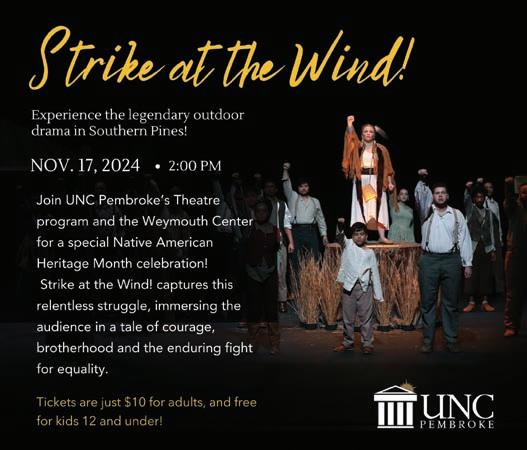
DECEMBER 7 & 8: Wonderfest & Market
10:00-5:00 pm
Tour the Boyd House decorated for the holidays, buy holiday decor in the Holiday Shoppe, grab a treat and a warm drink from our Bake Shoppe, visit Santa, shop local vendors and artisans and more!
See the Boyd House decorations from December 9 - December 27.


Scan the QR code for tickets and additional information!
555 East Connecticut Avenue, Southern Pines, NC






Ave., High Point. Info: highpointmuseum.org.
SUNDAYS
BARRE CLASS. 10 a.m. Strengthen, tone and stretch your way into the week. Tickets: $10. Grandover Resort & Spa, 1000 Club Road, Greensboro. Info: grandoverresort.com.
SIT, SPEAK. 4:30–5:15 p.m. Megan Blake, The Pet Lifestyle Coach, provides free group training and real time practice as you learn to connect more deeply with your four-legged, best friend. Free. LeBauer Park, 208 N. Davie St., Greensboro. Info: greensborodowntownparks.org/calendar.
TUESDAYS
PELVIC HEALTH YOGA. 8:30–9:30 a.m. This Vinyasa-style flow class works toward lengthening and strengthening the pelvic floor and surrounding muscles. Free, registration required and donations accepted. Triad Pelvic Health, 5574 Garden Village Way, Greensboro. Info: triadpelvichealth.com/classes.
WEDNESDAYS
LIVE MUSIC & PAINTING. 6–9 p.m. Evan
Olson and Jessica Mashburn of AM rOdeO play covers and original music while artist-inresidence Chip Holton paints. Free. Lucky 32. 1421 Westover Terrace, Greensboro. Info: lucky32.com.
THURSDAYS
JAZZ AT THE O.HENRY. 6–9 p.m. Sip vintage craft cocktails and snack on tapas while the O.Henry Trio performs with a different jazz vocalist each week. Free. O.Henry Hotel Social Lobby, 624 Green Valley Road, Greensboro. Info: ohenryhotel.com/o-henry-jazz.
WALK THIS WAY. 6 p.m. Put on your sneakers for a 2–4 mile social stroll or jog with the Downtown Greenway Run & Walk Club, which is open to all ages and abilities. Free. LoFi Park, 500 N. Eugene St., Greensboro. Info: downtowngreenway.org/events.
EASY RIDERS. 6–8:30 p.m. All levels of cyclists are welcome to ride along on a guided 4-mile cruise around downtown. Free. Lawn Service, 208 N. Davie St, Greensboro. Info: greensborodowntownparks.org/calendar.
THURSDAYS & SATURDAYS
KARAOKE & COCKTAILS. 8 p.m. until midnight, Thursdays; 9 p.m. until midnight,


Saturdays. Courtney Chandler hosts a night of sipping and singing. Free. 19 & Timber Bar at Grandover Resort & Spa, 1000 Club Road, Greensboro. Info: grandoverresort.com.
FRIDAYS & SATURDAYS
LIVE MUSIC. 7–10 p.m. Enjoy drinks in the 1808 Lobby Bar while soaking up live music provided by local artists. Free. Grandover Resort & Spa, 1000 Club Road, Greensboro. Info: grandoverresort.com.
SATURDAYS
YOGA. 9:30 a.m. Don’t stay in bed when you could namaste in the spa studio. Tickets: $10. Grandover Resort & Spa, 1000 Club Road, Greensboro. Info: grandoverresort.com.
WATER AEROBICS. 10:30 a.m. Make a splash while getting a heart-pumping workout at an indoor pool. Tickets: $10. Grandover Resort & Spa, 1000 Club Road, Greensboro. Info: grandoverresort.com.
BLACKSMITH DEMONSTRATION. 10 a.m.–4:30 p.m. Watch a blacksmith in action as he crafts various iron pieces. Free. Historical Park at High Point Museum, 1859 E. Lexington Ave., High Point. Info: highpointmuseum.org. OH



























































Blueprints and Bubbly Habitat Greensboro’s House Party
Piedmont Hall • September 19, 2024





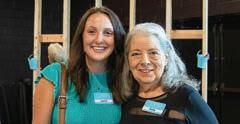












Kirkwood
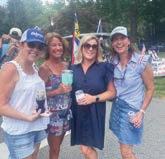
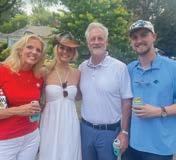

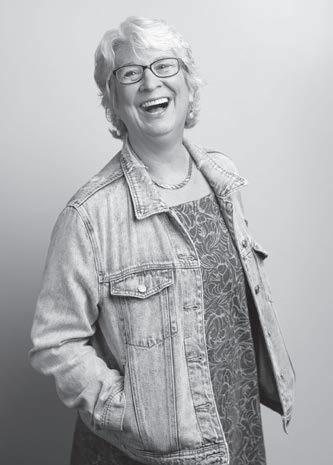


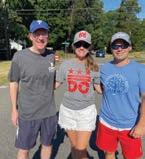
















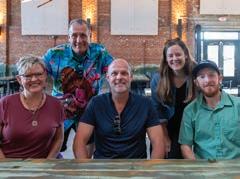

Downtown Greensboro • September 6-8, 2024

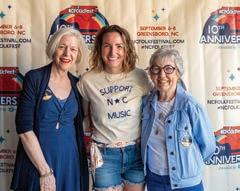

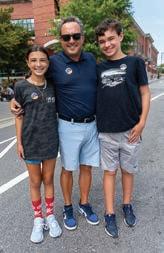
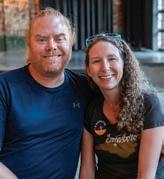

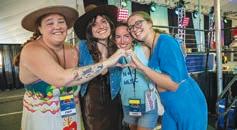







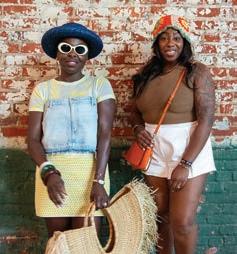
By R ichie Zweigenhaft
Not long ago, one of my geezer b-ball buddies sent me an article about pick-up basketball. I liked it, and I also liked the 31 comments that followed from various readers. I decided to add my own. A few minutes after I submitted it, I received a message telling me it had been denied — either because of inappropriate wording or because I had otherwise not followed the guidelines. I was told I could appeal. So I did, asking what I naively thought was a person just why it had been rejected.
Too long? I asked. Or was it because I had (shamelessly) included a URL promoting my book about our pickup basketball game? Or was it some other transgression (I was unable to find their guidelines online)? Ten minutes later, I was told my appeal had been rejected, and my question about the cause of the rejection remained unanswered.
Stubbornly, I attempted to submit my comment twice more, first taking out the URL, and then shortening the comment. Both times, it was rejected. Then I removed “geezer” and, presto, it was accepted. The term “geezer,” which I use affectionately, clearly was not acceptable based on the algorithm. It dawned on me that I had been “communicating” with a machine.
Subsequently, I had a radically different experience when I submitted an email to Phillip Fleischmann, the director of Greensboro’s Parks & Recreation. I addressed a fairly long (and somewhat rambling) message to him, asking him to forward it to the right person. The gist? Just some observations I had made on my regular bike rides about the tennis courts, ball fields, basket-


ball courts and the skateboard park I frequently ride by. It also included a query about the removal of planted areas along Buffalo Creek, plus about some renovations near the Latham Park tennis courts. And then I boldly suggested that some pickleball courts be added to the changes taking place in Latham Park. I even included a parenthetical comment informing him that, in 1975, as I was about to leave for a vacation, I had sent the Parks & Recreation department a letter encouraging them to build a basketball court in my Lake Daniel neighborhood. When I got back three weeks later, there was a court.
I had no idea if I would hear back this time either from a human or via artificial intelligence.
The response was quite human, and more than I could have hoped for. He responded to every issue I raised, with explanations about the tennis courts — why some had pickleball lines but others did not — the reason for the removal of the planted areas along Buffalo Creek, the department’s hopes to increase the number of pickleball courts, and why some basketball courts allow for full court and others don’t. He even congratulated me for my 1975 letter: “Seeing the use of the basketball court at Lake Daniel, it is evident that your suggestion to Parks & Recreation in the 1970s was an impactful one!”
When I shared this email with a friend, his response was “Fleischmann for President!”
It was reassuring, especially in light of my earlier online experience trading emails with a machine. The incursion of artificial intelligence may be inevitable, and may feel like it is pervasive, so responses like the one I got from Phil Fleischmann are increasingly valuable, especially to geezers like me who still value the printed word — written by humans. OH
Richie Zweigenhaft taught psychology at Guilford College from 1974 until 2020. He is the author of GEEZERBALL: North Carolina Basketball at its Eldest (Sort of a Memoir).




O.Henry magazine is pleased to present the 2024 Guide to Giving.
As you begin planning for the holidays, please consider how you may be able to help these nonprofit organizations that are working to make our community a better place to live.
The O.Henry magazine Guide to Giving is a sampling of charitable organizations in our area that rely heavily on annual fundraising. With your help, whether it be with your time or treasure, we can support their missions and have a hand in bettering our community.
We thank the local business leaders and individuals who made our Guide to Giving possible through their sponsorship.
To learn about sponsoring a nonprofit organization in 2025’s Guide to Giving, please call 336-617-0090.

PO Box 87 Hampstead, NC 28443 www.carolinaboxerrescue.
MISSION STATEMENT
To balance the health, safety, and welfare needs of Boxers in the Carolinas, Virginia, and parts of GA by providing a loving and safe environment for stray, abused, impounded and owner surrendered dogs by placing them in foster homes and ultimately – forever homes.
If you are interested in volunteering with Carolina Boxer Rescue, you can fill out an application on our website https://carolinaboxerrescue.org/volunteer-form/
We have multiple ways of donating. You can do so through Venmo @carolinaboxerrescue via Paypal www.paypal.me/savethenubs, by check, PO Box 87, Hampstead, NC 28443
Carolina Boxer Rescue is a 100% volunteer-run 501c3 organization that is completely foster-based. The rescue has been saving boxers since 2001. In that time, the organization has saved over 6,000 boxers. Carolina Boxer Rescue has over 200 volunteers.
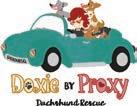

info@doxiebyproxy.org www.doxiebyproxy.org
Established 2019
We are a foster home based rescue accepting shelter intakes and owner surrenders from NC. We try to counsel and offer advice to owners considering surrendering their dachshund as a way of keeping pets in loving homes to prevent the burden on rescue.
We accept donations in the following ways: Venmo - @DBPRInc • PayPal - info@doxiebyproxy.org
Mailing Address: PO Box 9671, Greensboro, NC 27429-9671 Facebook Donations
• We have rescued and placed 1,127 dogs since 2019 and paid out over $1,000,000 in veterinary bills.
• 100% of our intake and adoptions are within 3 hours of Central NC.
ThisadmadepossiblebyAllPetsConsidered


To make disciples who reach UP to God, IN to the church, and OUT to the world.
Gospel-centered worship • Fervent prayer
Multigenerational fellowship
Intentional discipleship • Service in ministry
Missional Living
www.summerfieldfbc.com/give

2300 Scalesville Rd, Summerfield, NC 27358
336.643.6383 www.summerfieldfbc.com
Established 1860
By God’s grace we strive to be a multigenerational, gospel-centered, disciple-making church family reaching Summerfield and beyond for the cause of Christ. We actively serve our community through our food pantry, school partnerships, serving meals to those in need, building ramps for those needing handicap home accessibility and other ways. Our multigenerational ministries serve all ages including children, youth, adults, and senior adults.
Worship on Sunday mornings at 10:30am. For Sunday evening and Wednesday evening schedules, please visit us online at www.summerfieldfbc.com.



The P.O.W.E.R Of Play Foundation is a 501 c (3) organization. We want to provide financial assistance to at-risk children in the Triad and throughout North Carolina. We serve these children through scholarships, programming, sports leagues, after school/summer care, Christmas gifts, etc. We believe every child deserves to grow and develop in a safe and loving environment, whether that means spending time at Proehlific Park or with another non-profit
To volunteer you can reach out to Natasha Hilburn at foundation@proehlificpark.com.
Please go to our website at www.proehlificpark.com under the Our Foundation tab to donate.
We serve school age children from the ages of kindergarten to middle school for our after school and summer care. We also serve over 300 foster children each Christmas with Christmas gifts.
• Our Trunk or Treat will be held on Wednesday, October 30th from 4:30-6:30pm.
• The P.O.W.E.R Of Play Foundation supplies Christmas gifts for over 300 children each year in our Santa’s Helpers program. Mentoring, sports programs, and most importantly financial assistance for after school and summer care for youth in our community ranging in age from kindergarten through middle school. Santa’s Helpers/Gia private event will be held on Thursday, November 7th from 6:30-10pm. Tickets and sponsorship still available. Go to the website for information.

Please consider being a part of something bigger than yourself this Christmas by blessing local foster children. The POWER of Play helps these children have gifts Christmas morning because of people like you. Wish lists can be picked up the week of November 6th, and all gifts need to be delivered to Natasha Hilburn no later than November 27th, unwrapped with the wish list attached. 4517 Jessup Grove Road
| www.proehlificpark.com





With our community and partners, we will increase food security and create pathways that build a stronger Northwest North Carolina.
At Second Harvest Food Bank, we offer volunteer opportunities almost every day. Whether you’re sorting food, preparing meals for seniors and children, working in our teaching garden, or assisting in our offices, you’ll be part of a dedicated community making a real impact. Together, we work to ensure food access with dignity, promote better health, and create pathways to employment.
Get involved today and make a difference at SecondHarvestNWNC.org

Everyone deserves to eat. With every $10 you give, the Second Harvest network can provide up to 60 nutritious meals. Make your gift at FeedCommunityNow.org.
Second Harvest serves as an essential source of food for a network of 500 food assistance programs; supports individual and community health; provides pathways to employment through job training; and advocates for policies that lift North Carolina families.
• Food is the foundation for each of us to live our best life and for our communities to thrive.
• Second Harvest data continue to show a rise in the number of people seeking food assistance.
• Your support through gifts of time, food, and funds plays a pivotal role in our mission to build food secure communities and create pathways to a stronger Northwest North Carolina.
Thisadmadepossiblebyananonymoussponsor


Turning Entrepreneurs Into Business Owners
We utilize SCORE volunteers to assist our Associates and entrepreneurs with their start up needs. To volunteer go to https://www.score.org/volunteer.
Donations can be made through our website. https://nussbaumcfe.com/donate/

1451 S Elm-Eugene St, Greensboro, NC 27406
336.379.5001
www.nussbaumcfe.com
Established 1987
The Nussbaum Center for Entrepreneurship is the largest small-business incubator in North Carolina; with a 37-year history of helping area entrepreneurs and small business owners develop their business concepts into successful and sustainable companies. We offer scalable and modestly priced space, shared support facilities and services, along with business and technical assistance through a network of ten in-house partners.
• Serve 3000 small businesses annually
• 10 local, regional, state and federally funded Agencies to assist start-ups and small businesses
• Shared-use commercial kitchen available for hourly rental
• Manufacturing and Warehouse space in the newly renovated Steelhouse


American Building Services, Inc. (ABS) is a Commercial Janitorial Company that specializes in cleaning multi-story office buildings. Current Customers include commercial office, medical office, industrial, and manufacturing. We also have a division that offers Post Construction cleaning and General Trades for Commercial General Contractors. Our team has the expertise of a national company and the personal touch of a local company. If there is a problem there will be no excuses - we will fix it and work hard so that it won’t happen again. ABS is minority owned and HUB certified. Please reach out if you are in need of a quote for any commercial janitorial related services.




Seeking to put God’s love into action, Habitat for Humanity brings people together to build homes, communities, and hope.
Volunteers are at the heart of each Habitat home. Every volunteer helps families build a foundation for a brighter future. For more information and to register to volunteer, please visit: HabitatGreensboro.org/volunteer.
Every donation helps build safe, stable, and affordable housing. Donate securely online at: HabitatGreensboro.org/give.
Habitat Greensboro works toward our vision of a world where everyone has a safe and affordable place to live. Families with low-income, who have a demonstrated need, an ability to pay an affordable mortgage, and a willingness, partner with Habitat Greensboro to achieve the strength, stability, and self-reliance they need to build better lives for themselves and their children.
• Since 1987, Habitat Greensboro has helped nearly 550 families in Greensboro achieve their dream of homeownership.
• Habitat Greensboro has been instrumental in the development of over $51,500,000 in taxable home value to the local community.
• The current equity of Habitat Greensboro homeowners is more than $38,000,000.


To promote the right of every child to a permanent, safe, and loving family.
www.chsnc.org/get-involved
HOW TO DONATE
• 800.632.1400
• www.chsnc.org/donate
• Contact Caitlin Stay, cstay@chsnc.org, 336-369-3781
PO Box 14608, Greensboro, NC 27415
336.632.1400 www.chsnc.org
Established 1902
Children and families in all 100 North Carolina counties in need of foster care, adoption, family preservation, and education services so that children can thrive. CHS helped more than 23,000 clients last year, with a statewide staff and offices in 9 cities across North Carolina.
• Since our founding in 1902, CHS has placed more than 16,400 children with nurturing adoptive families.
• We help parents be the best that they can be by providing critical tools and resources for them to build stronger families. Whether that means doing whatever we can to keep families intact and healthy, or finding the right match to create new ones through foster care and adoption.
ThisadmadepossiblebyTruliantFederalCreditUnion
November is National Adoption Month.
Please consider fostering, adopting, or just learning more at chsnc.org.



inform. connect. educate. inspire.
https://www.wfdd.org/wfdd-upcoming-events
Go to wfdd.org and click GIVE NOW in the menu.
1834 Wake Forest Rd. #8850
www.wfdd.org
88.5 WFDD, Public Radio for the Piedmont, is the only public radio station of its kind located in the Piedmont Triad. We broadcast news, information, and public affairs programming covering the arts, people, and institutions in the area to 32 counties in North Carolina and southern Virginia.
• WFDD is the state’s charter NPR® member
• WFDD is the longest continuously broadcasting public radio station in North Carolina
• 88% of WFDD’s funding comes from our listeners
Thisadmadepossiblebywfdd


those who need it most. It’s the heartbeat of our community, connecting us to what matters. Support local journalism — when we’re informed, we’re stronger together.






1589 Skeet Club Road, Suite 102-111
High Point, NC 336-393-0000
www.LPPNC.org
LPPNC was formed to rescue and rehabilitate “castaway” dogs and cats and find them loving, forever homes. LPPNC offers spay/neuter financial aid to NC residents who would otherwise not be able to afford to get their pet/s altered. We feel this portion of our mission will provide the biggest impact to the pet overpopulation crisis.
Website: lppnc.org
Venmo: @lppnc (0000)
Paypal: paypal.me/LPIA
• Since 2010, LPPNC has found homes for 1103 dogs and cats and sponsored the spay or neuter of 13,655 dogs and cats. LPPNC is an all volunteer staffed organization with 98% of donations directly funding the care of dogs and cats.

8653 NC Hwy 65 Stokesdale, NC 27357
Our mission is to rescue, rehabilitate and rehome animals of all shapes and sizes from horses to hamsters, including dogs and cats by utilizing a network of foster homes!
To donate, foster or volunteer, please visit our website at reddogfarm.com. There you will find foster, volunteer, and adoption applications plus a wishlist of needed items. Monetary donations can be made through our website or by sending a check. Thank you!
• Being privately funded and foster based, any donation of time or resources helps!


Restoration Place Counseling exists to facilitate emotional and spiritual healing in girls and women by providing significantly-discounted, highly-professional, Christian counseling services.
Email cindy@rpcounseling.org
Our donors, the Mountain Movers Club, close the gap between what a client pays and the actual cost of providing services. To help move financial mountains so more women can access affordable care, join the club today at https://rpcounseling.org/donate/

1301 Carolina Street, Suite 114, Greensboro, NC 27401
336.542.2060
www.rpcounseling.org
Established 2005
Girls and women, age 12 and up
• Each year, millions of Americans with mental illness struggle to find mental health care. Nearly half of the 60 million adults and children living with mental health conditions in the United States go without any treatment. An hour-long traditional therapy session can range from $100 to $250. As a result, many people cannot access mental health care when they need it most.
• At Restoration Place Counseling, we strive to remove the barrier of high cost by offering a significantly-discounted sliding scale, based on annual household income, that ranges from only $25 per session to our standard rate of $150 per session.
• Since our founding in 2005, we have served more than 7,000 girls and women.
ThisadmadepossiblebySimplyMeg’s

Elevate your style with our expertly curated collection of clothing, shoes, and accessories for every part of your life – from work to weekends, special events to everyday style, and everything in between!


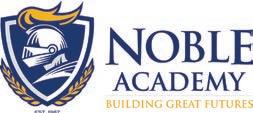
Noble Academy empowers students with learning differences to pursue their highest potential within a comprehensive, supportive educational environment.
We develop self-advocacy skills. We develop reading and math confidence. We bring back a student’s love for learning.
Donations are received at our website, www.nobleknights.org or directly at Noble Academy to the attention of Director of Development.
Students in grades 2-12 with a primary diagnosis of ADHD and learning disabilities or primarily experiences difficulties with attention, processing speed or memory, auditory processing, executive functioning, reading, math, or writing, and academic fluency, who match our admission criteria.
• 8:1 student/teacher ratio
• 100% graduation rate
• 1/3 of families receive tuition assistance or grants/scholarships from NCSEAA.
• Accreditations from SAIS, IDA, COGNIA, and a Wilson® Accredited Partner -Best Practice Site.

Thisadmadepossibleby Guilford



AuthoraCare Collective empowers people to be active participants in their care journey, enabling them to live on their own terms through personalized support for mind, body and spirit. Our patients are always the author of their life story.
Our volunteers at AuthoraCare Collective truly make a difference, and they perform a variety of services. You can be a part of a wonderful team of local people (currently 300+) who serves others. Whatever scenario fits your unique skills and personality, AuthoraCare needs you! Call us at 336.621.2500 to request an application.

2504 Summit Avenue Greensboro, NC 27405 336.621.2500 www.authoracare.org
Hospice of Greensboro Established 1980 Hospice of Alamance Established 1982
Your tax-deductible gift, processed through the AuthoraCare Foundation (Federal Tax ID 47-1169471), will ensure that AuthoraCare continues its mission of empowering people to be active participants in their care journey, enabling them to live on their own terms through personalized support for the mind, body and spirit. www.authoracare.org/give/donate-online or call 336.621.2500
AuthoraCare Collective covers a 12-county area with offices in Greensboro and Burlington.
In addition to hospice and palliative care, AuthoraCare Collective offers grief counseling, advanced illness care and Kids Path.
ThisadmadepossiblebyHanesLineberryFuneralServices
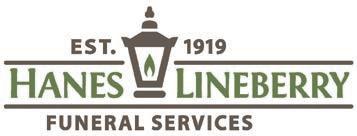


To improve lives and enrich communities through the power of work.
To improve lives and enrich communities through the power of work.


We have volunteer opportunities available, including individual, group, or corporate options. Complete our volunteer application at volunteer@triadgoodwill.org Volunteers must be 16 years or older.
We have volunteer opportunities available, including individual, group, or corporate options. Complete our volunteer application at volunteer@triadgoodwill.org Volunteers must be 16 years or older.
Financial donations can be made securely online at: donorbox.org/triadgoodwill. We also graciously accept donated goods at all 24 of our retail store locations. We accept electronics, clothing, furniture, collectibles, books, housewares, and more! See triadgoodwill.org/donate for more information or to host a donation drive.
Financial donations can be made securely online at: donorbox.org/triadgoodwill. We also graciously accept donated goods at all 24 of our retail store locations. We accept electronics, clothing, furniture, collectibles, books, housewares, and more! See triadgoodwill.org/donate for more information or to host a donation drive.

1235 S. Eugene St. Greensboro, NC 27406
1235 S. Eugene St. Greensboro, NC 27406
336.275.9801
336.275.9801
TriadGoodwill.org
TriadGoodwill.org
Established 1963
Established 1963



Goodwill Industries of Central North Carolina, also known as Triad Goodwill, is a vital community resource helping individuals overcome barriers that separate them from gainful, long-term employment. We provide training, support, career readiness resources, and employment in our community.
Goodwill Industries of Central North Carolina, also known as Triad Goodwill, is a vital community resource helping individuals overcome barriers that separate them from gainful, long-term employment. We provide training, support, career readiness resources, and employment in our community.
• 2,146 job seekers were served between July 2022 - June 2023
• 2,146 job seekers were served between July 2022 - June 2023
• 69% of all participant job placements were permanent, full-time positions
• 69% of all participant job placements were permanent, full-time positions
• Average job placement entry level pay was $18.34/hour
• Average job placement entry level pay was $18.34/hour
• Skilled training opportunities include Class A CDL, HVAC, and Construction Trade (NCCER) certifications.
• Skilled training opportunities include Class A CDL, HVAC, and Construction Trade (NCCER) certifications.



• Over 15 million pounds of donated product was diverted from landfills, and over 1 million pounds of cardboard, e-waste, and metal were recycled.
• Over 15 million pounds of donated product was diverted from landfills, and over 1 million pounds of cardboard, e-waste, and metal were recycled.

ThisadmadepossiblebyHILBGroup







HILB GROUP proudly supports Goodwill Industries of Central North Carolina, Inc. and their valuable work improving lives and enriching communities through the power of work.
Goodwill Industries of Central North Carolina, Inc. and their valuable work improving lives and enriching communities through the power of work. Sharon Weikel – Vice
(336) 774-2788 | Mobile: (336) 529-9642 sweikel@hilbgroup.com



United Way of Greater Greensboro creates, connects, and leads community partnerships that equip and empower people to leave poverty.
THANKS TO YOUR GENEROUS SUPPORT, AND THE LONGSTANDING SUPPORT OF MORRISETTE PACKAGING, A FAMILY OWNED COMPANY BASED IN GREENSBORO, NC...
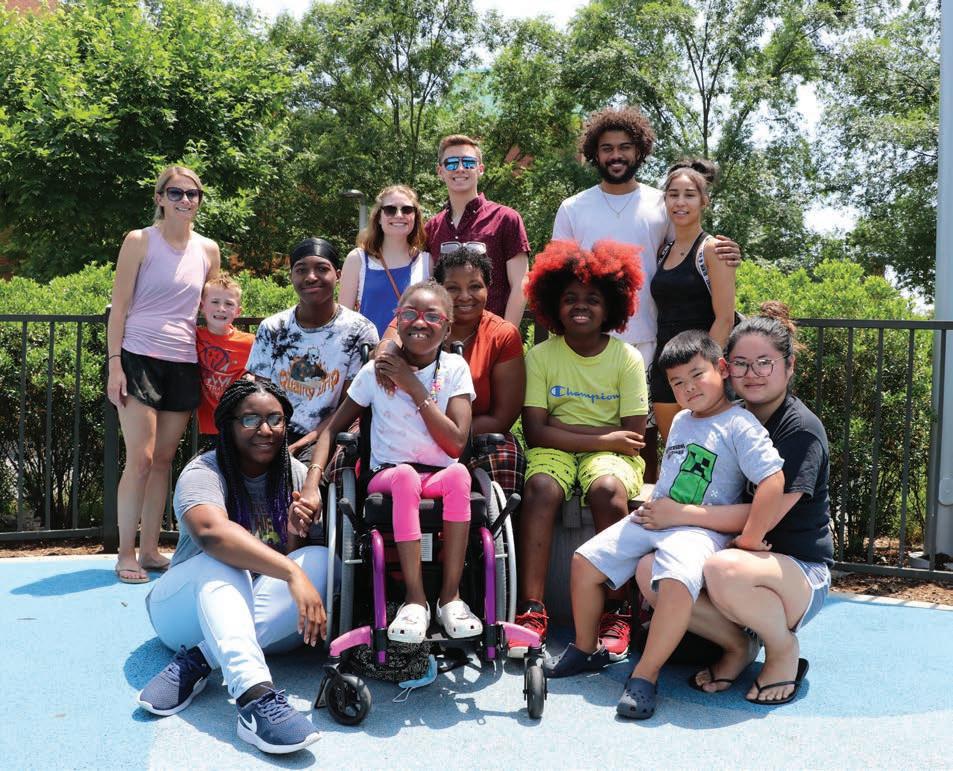

Larry learned to read, landed a job, received a promotion with a raise and is considered a model employee by the company.

Rosalia connected to United Way’s Thriving at 3 program and learned parenting skills to help her son’s development.

Jarvis received support for the critical repairs necessary to keep his house safe, amidst health and financial issues.









